Gregory A. Fournier's Blog, page 2
April 14, 2024
2023 Radio Hall of Fame Inductee Pat St. John
 Pat St. John at the SXM control panel.
Pat St. John at the SXM control panel.
In Pat St.John’s senior year at Southfield High School, Pat began broadcasting from WSHJ,their ten-watt radio station. He was required by the Federal Communications Commissionto get a broadcasting license. Upon graduation in 1968 at the age of seventeen,Pat was hired as an announcer on WWWW-FM in Detroit.
Young andambitious, Pat made a demo tape and took it to CKLW-AM, a 50,000 watt station acrossthe Detroit River in Windsor, Ontario, Canada. The station’s strong signal wasa regional powerhouse reaching well beyond the Detroit/Windsor area to severaladjoining states and Provinces.
CKLW-AMhired Pat in 1969 as a weekend personality and news reporter on the station’s20/20 newscasts. He also worked as a booth announcer for CKLW TV-Channel 9. Patleft CKLW late in 1970 when he was hired at Detroit’s popular WKNR (Keener 13)until 1972, when he was lured away to join ABC’s WRIF-FM, 101.1.
Musicaltastes had shifted from Top 40 pop music to album-oriented rock. In the early1970s, FM radio began dominating AM stations because they broadcast in stereoand allowed for a wider range of music beyond the Top 40 playlists, staples ofmany AM stations.
Pat St. John’sratings in the Motor City were noticed by ABC’s network brass in New York andthey convinced him to leave his hometown Detroit, America’s fifth-largest media marketat the time, and move to The Big Apple, the largest media market in the UnitedStates. Radio stations in New York reached 14% of American listeners. The more listeners a Dee-Jay could attract,the more money was at stake for the company’s advertising revenue.
St. Johnbegan his New York broadcasting career at WPLJ-FM in 1973 where he stayed almost fifteen years.Arbitron, radio’s consumer research service, ranked Pat the most listened-toafternoon radio personality in the country for most of the years he worked atWPLJ.
From 1987through 1998, Pat worked at WNEW-FM in New York, both as a personality and thestation’s program director for several years of his eleven year stay there.He left WNEW-FM when the station changed to a “talk radio” format. Patwas immediately approached by Sirius XM satellite radio to become theirDirector of Rock Programming, making him one of the first people hired by thecompany.
Now, Pat isone of the longest-serving employees at SXM, having worked on several of their channelsfrom pop to rock to blues. Today, Pat can be heard live across the United States and Canada every weekday afternoon(3 pm Eastern/12 pm Pacific) and Saturday evenings (8 pm Eastern/5 pm Pacific) on Channel 73, 60’s Gold.
 Pat continued working on New York (terrestrial) radio part-time for fun at WCBS-FM(2000-2015) while working full-time at Sirius XM. His final CBS-FM New Yorkbroadcast was on April 12, 2015, marking the end of Pat’s forty-two-year run in the New York broadcastingmarket, making him New York City’s longest-running on-air personality up tothat time.
Pat continued working on New York (terrestrial) radio part-time for fun at WCBS-FM(2000-2015) while working full-time at Sirius XM. His final CBS-FM New Yorkbroadcast was on April 12, 2015, marking the end of Pat’s forty-two-year run in the New York broadcastingmarket, making him New York City’s longest-running on-air personality up tothat time.Pat andhis wife Jan moved to San Diego, California in 2015 to be closer to their twodaughters and grandchildren where he broadcasts from his home studio. Pat’s 60sGold show begins with a six-note fanfare reminding Pat’s Great Lakes listenersof his CKLW radio roots. Then, comes his theme song “Zing Went the Strings ofMy Heart” by Les Elgart and his Orchestra setting the stage for the show. Listenersalways know from the opening that they are in for a good time.
Pat St. John’son-air style is conversational and upbeat as he shares behind-the-scenesanecdotes about the music and performers between the music he plays. Pat hasinterviewed virtually everybody in the music business from Little Richard andBo Diddley to The Beatles and The Rolling Stones. He has been called “awalking, music encyclopedia."
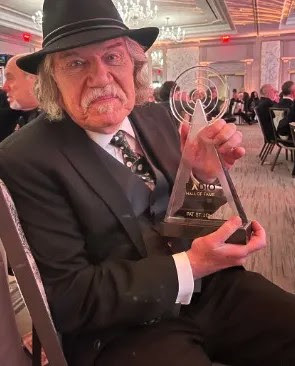 Pat St. John with his Radio Hall of Fame Award.
Pat St. John with his Radio Hall of Fame Award.
With overfifty-five years in broadcasting, Pat St. John was inducted into the Radio Hallof Fame in 2023 for his lifetime of service to the industry. Not bad for a highschool kid from Southfield, Michigan.
Pat St. John SXM Compilation (Six minutes)
March 16, 2024
Hissoner Detroit Mayor Coleman Young
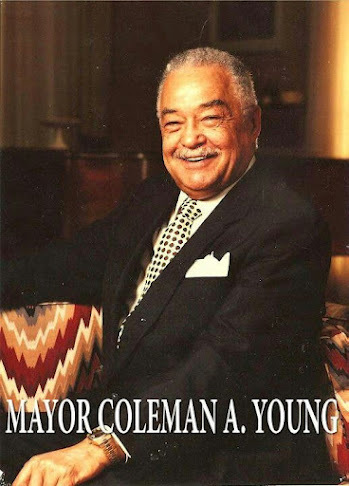
Coleman Young's identity, life, and career were closely intertwined with issues pertaining to the African American community in Detroit and the nation. As the city's chief executive officer for five full terms, more than any other Detroit mayor, Young served the city he loved for twenty years.
Throughout his political career, the White establishment, representing suburban interests and their media mouthpieces, viewed Coleman Young's ascendency to Detroit's mayor as a social trespass upon their political turf. But the demographics of the city were favorable for Young's election.
The phenomonon known as White flight decimated the city's population and tax base leaving crippling poverty in its wake. White flight redefined the city, first with the G.I. Bill for World War II veterans who moved to the suburbs, and after 1967 when Detroit experienced one of the worst race riots in the history of the United States.
Both of these demographic shifts happened years before Young was elected mayor in 1974. Factor in the virtual collapse of the city's main employer, the automobile industry, due to the oil crisis in the Middle East. This was the situation Mayor Young faced as he entered office and soon became defined by every urban social problem Detroit was heir to. He was the man in the moment.
***
Coleman Young began his boyhood in Tuscaloosa, Alabama, on May 24, 1918. His father William Coleman Young was a barber who sold a Black newspaper out of his shop. For this, the local KKK began a harrassment campaign prompting him and his growing family in 1924 to become part of what history notes as the Great Migration to the North in search of jobs in the automobile factories and steel mills. Impoverished Southerners, Black and White, poured into Detroit. The men competed for unskilled jobs on the assembly lines, steel mills, and iron foundries, while the women found work in the domestic services industry.
Coleman was five years old when his family moved to Detroit's Black Bottom neighborhood on Antietam Street between St. Aubin and the railroad tracks. He was the oldest of five children born to Ida Reese Young. As Coleman Young details in his autobiography Hard Stuff, he graduated from Eastern High School in 1935 during the depths of the Depression. To help support his family, he hustled to earn money doing small jobs. He recycled glass bottles, swept floors, delivered packages, and answered phones for Dr. Ossian Sweet.
Eventually, Young was hired as an autoworker for the Ford Motor Company. It was there where he joined the United Automobile Workers of America. After being fired from Fords for fighting, he went to work for the United States Postal Service before entering the service during World War II.
"My political consciousness was awakened at the neighborhood barber shop in Black Bottom where I shined shoes," Young wrote. "Local radicals educated me with dialogue that offered nothing about passivity or surrender but much about unity. As both a means and an end, unity has driven virtually every pursuit of my public life."
The two-chair, barber shop was owned and operated by Haywood Maben, "a self-educated Marxist and (political) pontificator." He and his customers would argue about trade unionism, dialectical materialism, and unity between the races which made for provocative conversation. Maben's barbershop was a left-wing caucus in the afternoon; at night, political meetings were held behind drawn curtains.
These meetings did not go unnoticed by the FBI, which recorded names of participants and labeled them Communist sympathizers and socialists. Coleman Young's name was included on that list leading to the opening of a confidential dossier on him which followed him through his adult life. Time and again, J. Edgar Hoover's FBI interfered with Young's ability to hold onto a decent job or get fair treatment in the Army Air Corp. All it took was a well-placed phone call or a letter from the FBI and Young's opportunities vanished into thin air.
***
With the end of World War II, Detroit was on a collision course with history. The post-war economy began shrinking rapidly as government military contracts expired. The Arsenal of Democracy scrambled to transition back to a peacetime economy. Nowhere was this felt more than in Detroit. To compound Detroit's economic woes, the G.I. Bill and the Veterans' Administration provided low-cost, zero percent down home loans that sparked a dramatic exit from the city which became known as White flight, further devastating the city's population and tax base.
Then came a gut punch which sealed Black Detroit's fate. President Eisenhower pushed for an Interstate Highway System based on the Autobaun, which he had seen in Germany at war's end. His primary argument for such a highway was it allowed the military to deploy personnel and equipment quickly to virtually anywhere in the country on expressways. In Detroit, local politicians saw this as an opportunity to clear out the depressed Black Bottom and Paradise Valley neighborhoods in the name of urban renewal.
The Black population regarded the construction of I-375 as little more than Negro removal. Local politicians gave no regard to the people who would be displaced or the impact it was destined to have on the city. Impoverished Black residents were forced into other underfacilitated, overpopulated, segregated areas within Detroit. In short, a powder keg of human misery was created waiting only for a spark to ignite and engulf the area. Up to this point, Detroit's African American community had little or no political influence.
Although not the first American urban area in the 1960s to erupt in civil unrest, the Detroit Riot/Rebellion began on July 23, 1967. It became the most devasting race riot of the era. President Lyndon B. Johnson sanctioned a federal investigation in 1968 into its causes and of other urban civil disorders called The Kerner Commission.
The Commission determined after an exhaustive study that the rioting in Detroit was a response to decades of "persausive discrimination and segregation." The siege mentality of the mostly White, aggressive, and combative Detroit Police Department was singled out in particular.
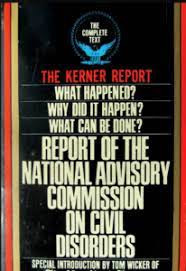
After the week-long rebellion, Detroit public opinion polls revealed that 75% of White respondents believed the rioting was caused by radicals guided by a foreign conspiracy to overthrow the American government and our way of life--specifically, Pinko Commies and Black Panthers.
Conservative politicans disputed that the blame fell on White institutions or White society and took no ownership of the issue. Most White people were dismissive and believed that the rioters were criminals who were "let off the hook" by bleeding-heart liberals.
Refuting that popularly held suburban belief, the Kerner Commission determined that the insurrection was a revolt of underprivileged, overcrowded, and irritable citizens. During a blistering heatwave, they reacted against a provocative police raid that provided the spark igniting the week-long rebellion.
The Commission concluded that the root cause of the violence was institutional racism. American society in general is "deeply implicated in the ghetto," the report read. "White society created it. White society maintained it. And White society condoned it."
Ironically, President Johnson, who initiated the study, was unhappy with the result because the Commission's recommendations were all budget busters with no chance of passage in the United States Congress. Johnson was also a man from the South and knew there would be political repercussions if he threw the weight of the presidency behind the Committee's recommendations.
As cruel fate would have it, one month after the Kerner Report was published, Martin Luther King Jr was assassinated while standing on the Lorraine Motel balcony by James Earl Ray in Memphis, Tennessee. America's best hope for pulling our nation out of this racial quagmire was cut down in his prime. Grief and anger broke out across the land and demonstrations occured in over one hundred American cities. The Kerner Report was back-shelved and conveniently forgotten.
In Detroit, a new wave of White flight made Detroit the Blackest city in the United States. African Americans were now in the political majority.The stage was set for a new generation of Black leaders who would struggle to lift Detroit out of its death spiral. The most visible among them--Coleman Young Jr.
***
Young began his political career coming from the left-wing branch of the American labor movement. He became a respresentative for the Public Workers Union and devoted himself to full-time union organizing. By 1946, Young won a leadership role as a director within the larger Congress of Industrial Organization (CIO). His election to the position was a major victory for the Black community, and he instantly became a spokesperson for Blacks across Detroit.
Earning a reputation as a devoted and hard-working labor organizer in the 1950s, Young was elected to the Michigan House of Representatives in 1960. He helped draft a new state constitution for Michigan, which in turn led him to run for State Senator in 1964, a position he held for ten years making a name for himself as an effective legislator.
In 1970, Wayne County Sheriff Roman Gribbs became mayor of the City of Detroit running on a law and order platform. Gribbs hired former New York Police Commissioner John Nichols. Together, they created a special police unit named STRESS, an acronym for Stop the Robberies, Enjoy Safe Streets, to apprehend street thugs and patrol in primarily minority-isolated neighborhoods. The group became simply known as The Big Four by the city's Black residents. The special unit soon devolved into what amounted to agents of urban terror.
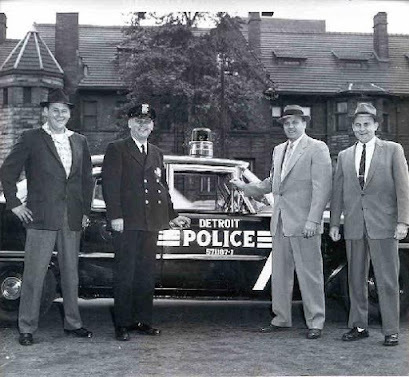 STRESS Police Unit
STRESS Police UnitSTRESS police cruisers consisted of a driver and three burly, usually White, plainclothed police detectives. The department had several such units. In less than three years, twenty-two Detroit citizens (twenty-one of them Black) were shot to death, hundreds of illegal arrests were made, and an estimated 400 warrantless police raids were conducted. Rather than protect the citizenry, The Big Four terrorized the city's Black residents.
In 1973, Roman Gribbs stepped down as mayor after a single term in office, throwing his support behind his police commissioner John Nichols, who ran on a law and order platform. Coleman Young saw this as an opportunity to leave the Michigan senate and run for Detroit mayor.
Young campaigned against the abuses of the Detroit Police Department which Black residents identified as their number one issue. He also ran on a platform of reconstructing the inner city, creating sorely needed jobs for city residents, and hiring city employees to reflect a 50/50 racial balance.
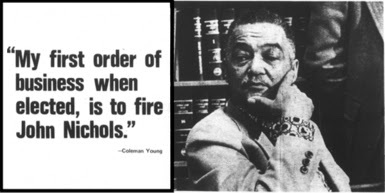
On election day there were no surprises. In this hard fought election, White precincts voted for Police Commissioner Nichols, and Black precincts voted for Coleman Young Jr., making Young Detroit's first Black mayor by earning 52% of the vote to John Nichols' 48%.
In his inaugral speech, Young urged unity between the races, White and Black, the rich and poor, and the suburbs and the city. He also spoke about restoring law and order.
Young addressed Detroit's criminal element directly, "Dope pushers, rip-off artists, and muggers, it is time for you to leave Detroit. Hit Eight Mile Road. I don't give a damn if you're Black or White, or if you wear Superfly suits or blue uniforms with silver badges. Hit the road!"
While Mayor Coleman Young's "New Sheriff in Town" speech resonated with many city residents, The White political establishment extrapulated it as an invitation for Detroit's Black criminals to prey upon the affluent White surburbs. The opposition's fear mongering was echoed and amplified by Detroit's media outlets. And thus, Coleman Young's new administration began.
Young's first political act was to disband the police STRESS units and move toward a community policing approach with mini stations located around the city. He also made good on his promise to hire more Black policemen. The percentage of Black officers went from 10% to 50% during his administration. The net effect was the reduction of police brutality complaints against the department by over 35%, improving police relations within Detroit's neighborhoods.
The nationwide recession of the mid-1970s hit Detroiters especially hard. Unemployment was at 25% increasing costs for public relief programs and reducing city income and property taxes. In 1974, Automobile production was at its lowest level since 1950, and the Middle Eastern oil embargo drove up inflation nationwide.
As if German Volkswagen imports in the 1950s and 1960s were not enough of a nuisance, in the 1970s, Japanese imports caught Detroit's Big Three (Ford, General Motors, and Chrysler) flat-footed with an large inventory of high-cost, gas-guzzling, luxury and muscle cars gathering dust in storage lots.
To vent the frustrations of laid-off auto workers, the UAW hosted fundraisers around the city where workers, or anybody else with a few bucks, could take a sledge hammer to a Toyota Corolla for a dollar-a-whack. These displays of the area's collective blue-collar angst did nothing but provide the local media with dramatic made-for-television news moments. The sledgefests also proved how well these imports were built. Most drove off under their own power after an afternoon of pounding.
The fundamental problem rested with the automobile executives who did not take the small car trend seriously and frantically rushed to produce economical cars which were inferior to Japanese imports.
As Detroit sank deeper into financial crisis, Mayor Young's second, third, and fourth elections were focused on creating jobs for city residents. Young's mantra was "Jobs built Detroit, and only jobs will rebuild it." The automobile companies decentralized and moved much of their manufacturing to the suburbs or to the South where wages were lower. That left Detroit out in the cold. The city could no longer depend on the auto business to enrich its coffers and pay its bills. Something huge and dramatic needed to happen.
Young tossed the dice and decided that casino gambling was the answer to his city's woes, especially after Windsor, Ontario, across the Detroit River approved gambling on their waterfront. For his next three election campaigns, Young made casino-style gambling the centerpiece of his political platform, much to the dismay of his most ardent supporters, the ministerial alliance of Black churches.
Young's most strident political opponents, the suburban power elite and their media machine hammered away at Young on a daily basis in the city's major newspapers and local news programs. Each time Young promoted casino gambling, the ballot measures were soundly defeated by a 2 to 1 margin in expensive and dirty campaigns.
For Young's fifth and final campaign for mayor, he did not make casino gambling part of his political platform. It took his successor Mayor Dennis Archer to win approval for casino gambling within the city limits.
With the State of Michigan running a daily and weekly lottery and Windsor's Caesar's Casino raking in a million dollars a week from Michigan residents, voters' attitudes about gambling softened. In 1996, the proposition narrowly passed. The creation of construction jobs, casino jobs, and vendor jobs did much to stablize Detroit's economy and help revitalize downtown.
Coleman Young decided not to run for a sixth term as mayor. His emphysema from a lifetime of smoking robbed him of his strength and energy. Twenty years serving the city he loved was enough. He fought long and hard to improve Detroit and left the city in better shape than when he entered office.
 The Renaissance Center
The Renaissance CenterDuring his tenure, the Renaissance Center was completed in 1977 creating jobs and increasing the city's tax base. The Hart Plaza, thirteen acres of people-friendly sidewalks and promenades along the bank of the Detroit River, humanized what was once a blighted area. It included an amphitheater hosting all manner of ethnic and music festivals bringing city and suburban audiences together.
Among many other large construction projects Young supported the People Mover, a light rail loop in the downtown area; Detroit Receiving Hospital; Riverfront Condominiums; and the FOX Theater restoration, looking out at what would become Comerica Park and Ford Field bringing the Tigers and the Lions downtown.
From the beginning of his political career, Coleman Young was accused by his critics of being corrupt. In a Freedom of Information Act investigation, Young discovered he had been under FBI surveillance since 1940 because of his reputed association with suspected Communists and his labor union activities. Surveillance continued through the 1980s.
After six federal investigations of his administration, Young was never indicted or charged with a crime. Claims that he was corrupt were malicious myths designed to tarnish the mayor's brass.
Young emerged from a left-leaning element but moderated his political view once in power. He allied himself closely with community leaders, business entrepreneurs, and bankers proving that rather than a socialist, Young was a devout capitalist committed to rebuilding Detroit and improving the lives of its residents. His vision for Detroit laid the foundation for much of the city's resurgence we see today.
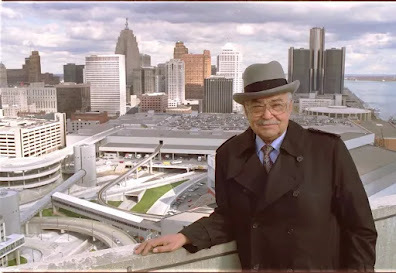 Coleman Young Surveying His Legacy
Coleman Young Surveying His LegacyAt the age of seventy-nine, Coleman Alexander Young succumbed to lung disease on November 29, 1997. The mayor's body laid in state for two days under the Rotunda in the Hall of Ancestors at the Museum of African American History in Detroit's cultural district.
Funeral services were conducted on Friday, December 5th by Reverend Charles Butler at the New Calvary Baptist Church. Aretha Franklin sang at the ceremony with the combined chorus of Greater Grace Temple and the New Calvary Baptist Church. Coleman Young was buried in a private ceremony in Elmwood Cemetery where many of Detroit's distinguished citizens are interred.
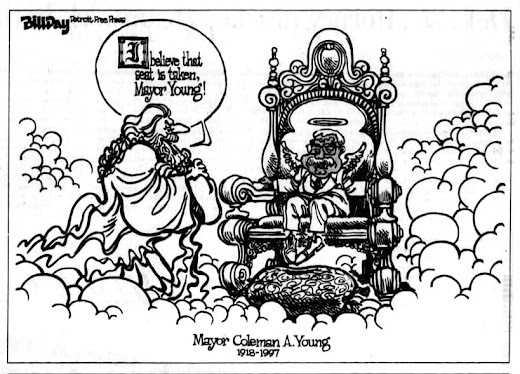
March 3, 2024
Alex Karras’ Made-In-Detroit Movie—Jimmy B. and Andre (1979)
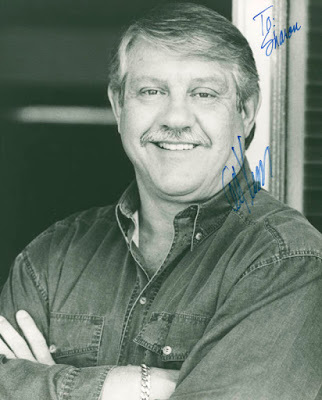 Alex Karras proves there is life after professional football.
Alex Karras proves there is life after professional football.When Alex Karras retired from the Detroit Lions in 1970, heleft town for the bright lights of Hollywood. Alex first caught the acting bugas a senior at Emerson High School in Gary, Indiana when he performed in South Pacific. When he played college football at theUniversity of Iowa, Karras wrestled professionally as villain George Browndonning a full mask and earning $50 a match. He relished playing the bad guyand acting crazy. It beat working in the steel mills.
After Karras was drafted by the Detroit Lions, he supplementedhis ridiculously low NFL salary by wrestling in the off-season to help pay thebills for his growing family. He formed a tag team called Killer Karras andKrusher Konovski that performed to boos and sneers while winning all of theirmatches in the Midwest. While still a Detroit Lion, Karras played himself inthe Hollywood film, Paper Lion. Hegarnered good reviews that led him to pursue an acting career.
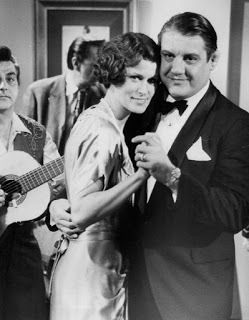 Karras with Susan Clark in BABE.Karras cut his teeth on several minor roles before he landeda co-star role in The Babe DidriksonZaharias Story with actress Susan Clark, who won a best-actress Emmy forher excellent performance. They began performing regularly together and eventuallymarried. In 1979, they jointly formed a Hollywood production company named Georgian Bay Productions.
Karras with Susan Clark in BABE.Karras cut his teeth on several minor roles before he landeda co-star role in The Babe DidriksonZaharias Story with actress Susan Clark, who won a best-actress Emmy forher excellent performance. They began performing regularly together and eventuallymarried. In 1979, they jointly formed a Hollywood production company named Georgian Bay Productions.Their first full length movie project was Jimmy B. and Andre which debuted on CBSon March 19, 1980. It was based on the true story of Jimmy Butsicaris, co-ownerwith his brother Johnny of the popular Lindell AC (Athletic Club) sports bar. TheLindell AC was frequented by Detroit Lion and Tiger athletes, sports writers,and sports fans from every level of Detroit society. Alex wanted to make amade-for-TV movie about his friend Jimmy B. trying to adopt a nine-year-old,African-American street kid named Andre Reynolds.
Andre was an elementary school dropout who shined shoes atJim’s barber shop next door to the Lindel AC to pick up some extra money. But anolder, local bully named Billy began harassing Andre for his hard-earned cash. JimmyButsicaris rescued the ragged, nine-year-old Andre from a beating one afternoon, findinghim in desperate need of a bath, a meal, and some guidance. Over a cheeseburger, fries, and a Coke, Jimmy learned the boy’s story. Andre’s mother was awidow who was also a heroin addict in poor health. Much of the money Andreturned over to her ended up in her arm. There was also an older sister andbrother in the household.
Jimmy took the kid under his wing and gave him work doing oddjobs and a place to stay in the basement storeroom of the bar. JohnnyButsicaris converted a photo darkroom into a safe place for Andre to stay. Helived there for nine years. After the death of Andre’s mother from an overdose,Jimmy tried to adopt Andre but ran into trouble with the boy’s aunt who wanted himand his siblings as dependents to earn extra welfare money.
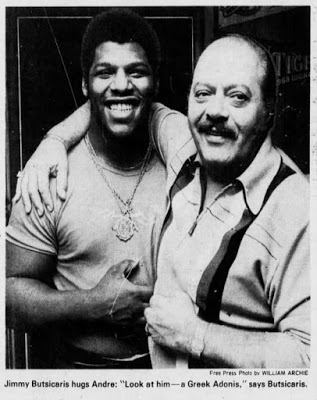 Detroit Free Press - March 20, 1980.Undeterred by the court’s decision to deny him guardianship,Jimmy became Andre’s foster father and treated him like a son. As Andre grewinto manhood, he called Jimmy “Pop.” To show his appreciation, Andre had ashirt made that read “I Am a Black Greek.” Jimmy took Andre to Detroit Lion andTiger games and introduced him everywhere as his son. Jimmy helped Andre getback in public school where he earned a high school diploma from Western HighSchool when he was twenty years old.
Detroit Free Press - March 20, 1980.Undeterred by the court’s decision to deny him guardianship,Jimmy became Andre’s foster father and treated him like a son. As Andre grewinto manhood, he called Jimmy “Pop.” To show his appreciation, Andre had ashirt made that read “I Am a Black Greek.” Jimmy took Andre to Detroit Lion andTiger games and introduced him everywhere as his son. Jimmy helped Andre getback in public school where he earned a high school diploma from Western HighSchool when he was twenty years old.In the meantime, Karras and Clark pitched their story idea toCBS and sold them on it. Karras portrayed his friend Jimmy Butsicaris as agruff restaurant owner with a big heart, and Susan Clark played hislong-suffering girlfriend Stevie. In the movie, Jimmy keeps finding reasons notto marry her. Karras’ son, Alex Karras Jr, played a cameo role as the bully whobeats up the young Andre, the real Andre played a restaurant employee calledBubba, and local Detroit weatherman Sonny Eliot played a drunk in the movie.
The movie project was shot entirely in Detroit at the LindellAC, Jim’s Barber Shop next door, the Greektown restaurant district downtown, BelleIsle Park, and the Renaissance Center. The film was notable because of the heart-rendingperformance of twelve-year-old Curtis Yates, a student at Country Day School inBirmingham, Michigan. The real Andre Reynolds said he cried every time he sawthe movie about his life and his foster father Jimmy Butsicaris.
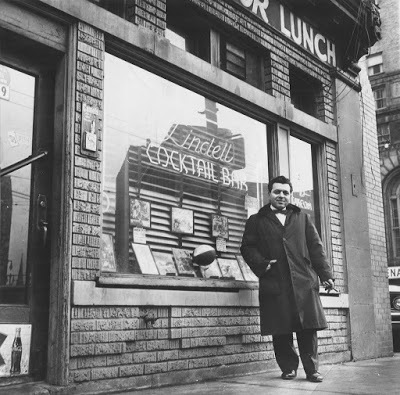 Johnny Butsicaris in front of the Lindell AC sports bar.
Johnny Butsicaris in front of the Lindell AC sports bar.After Andre’s high school graduation, Jimmy urged him toattend Grand Rapids Community College where he played football for onesemester, but at 5’ 9” and 185#, Andre wasn’t big enough for college ball, sohe dropped out. When Andre returned to Detroit, he left the influence of hismentor and drifted into Detroit’s drug culture. When he was busted forpossession and drug trafficking, Andre served his sentence in Marquette BranchPrison.
In a prison cell at Marquette Branch Prison in Michigan’sUpper Peninsula on November 21, 1996, thirty-six-year-old Andre learned thathis foster father and mentor Jimmy Butsicaris had died the evening before atthe age of seventy-five from a massive heart attack. Reynolds wasn’t eligiblefor parole, so he couldn’t attend the funeral, but he agreed to be interviewedby Detroit News reporter ThomasBeVier.
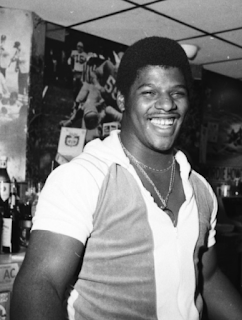 Andre Reynolds at Lindell AC in 1979.“(Jimmy) Butsicaris took me in when I was a nine-year-old,punk kid living in a drug infested environment. I had a few moments of famewhen the movie Jimmy B. and Andrecame out. I was nineteen and wanted to be an adult, but I didn’t know how to dothat. I was paid $15,000 for my story, and I used it to buy two cars and go to GrandRapids Community College. But along the way, I fell in with a rough crowd andwas in and out of trouble most of my twenties. I’m ashamed of the life I’velived.”
Andre Reynolds at Lindell AC in 1979.“(Jimmy) Butsicaris took me in when I was a nine-year-old,punk kid living in a drug infested environment. I had a few moments of famewhen the movie Jimmy B. and Andrecame out. I was nineteen and wanted to be an adult, but I didn’t know how to dothat. I was paid $15,000 for my story, and I used it to buy two cars and go to GrandRapids Community College. But along the way, I fell in with a rough crowd andwas in and out of trouble most of my twenties. I’m ashamed of the life I’velived.”Andre served his sentence and was released. A few days beforeThanksgiving in 2000, Andre Reynolds was brutally attacked by an unknown personor persons who beat and stomped him mercilessly. Detroit Police posited thatAndre ran afoul of a local drug gang, but no charges were ever brought in hismurder. He spent his final days in a coma at Detroit’s Receiving Hospitalbefore succumbing. His body was unidentified in the Wayne County Morgue forfour days before he was buried. What seemed on screen like a promising futurefor Andre became a nightmare in real life. Access Jimmy B. and Andre by name on YouTube!
Billy Martin's fight night at the Lindell AC
January 26, 2024
Five the Hard Way in Detroit's Gamble for Casino Gold
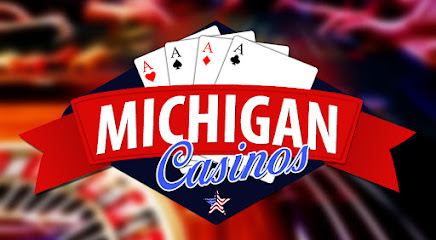
Detroit like almost everywhere else has a long history of gambling, but when it came to approving Las Vegas-style casinos within the city limits, it took voters five propositions and twenty-two years for supporters to outvote the opposition. Detroit's religious community mounted a campaign against what they felt was the moral decline of the city. Because Detroit's mayor Coleman Young was the spokesperson for the legislation to legalize casino gambling within the city limits, he became the focus for everything that was wrong about Detroit.
Mayor Young was confronted by a $44.3 million budget deficit by the end of the 1976 fiscal year, the largest operating deficit ever run by the city. To avoid the anticipated layoff of city workers, wage and hiring freezes, and incentives for early retirements, something decisive had to be done. The proposal to legalize casino gambling in Detroit was dubbed "the Circuit Breaker Proposal." It was sponsored in Lansing by Michigan House of Representive Democrat Casmer Oganowski.
The proposal called for a state casino gambling commission to license and regulate games of chance, namely blackjack (21), baccarat, keno, craps, roulette, wheel of fortune, and slot machines. It was not as if gambling and betting parlors were unknown in the city. Cards, dice, and other games of chance like flipping coins, pitching pennies, shooting pool, three card monte, and sports gambling were commonplace among Detroit's blue collar workforce.
 Three Card Monte
Three Card MonteIn the inner city, "playing the numbers" had long been part of the urban experience where bettors had much better odds of winning than in the Lottos run by the state of Michigan. In addition, backroom club gambling and poker rooms have always operated just below the surface of polite society for people who could afford losing money. Those who could not were soon given the bum's rush.
Many churches have long raised funds by hosting bingo nights and casino gambling charity events to add to their coffers. But Las Vegas-style casinos in one of America's largest cities posed a major threat to a city already struggling with more than its share of urban problems.
Fears of more organized crime, public corruption, increased poverty, prostitution, alcoholism, drug abuse, and immorality were the powerful talking points of the opposition. Because of the heightened emotion connected with this issue, Republican politicians and the Detroit News and Detroit Free Press came out firmly opposed to the proposition.
Supporters of casino gambling touted how many thousands of jobs would be created in a town with high unemployment and poverty. First, construction jobs would be created, and once the casios were operational, thousands of permanent jobs would be created. Casino gambling would revitalize Detroit's blighted downtown cityscape by generating an estimated $200 million in taxes with increased business revenues generated.
The day before the election, the Detroit Free Press urged voters to vote "No" on the advisory question to allow up to six state licensed and regulated casinos in Detroit. Voters defeated the gambling advisory referendum by 59% for a decisive win. Republican Governor William Milliken and the Detroit Area Council of Churches were the most outspoken opponents advocating the referendum's defeat. Michigan House of Representative Cass Organowski and Mayor Coleman Young vowed to continue supporting casino gambling within the Detroit city limits.
The day after the vote, the Detroit Free Press pronounced on its editorial page that the voters rejected "the siren song of the casino gambling backers. The idea that gambling would help the city renew itself is misleading and diverts attention from tackling the real problems of crime, poverty, and affordable housing."
 Snake Eyes
Snake Eyes***
Since Detroit's casino gambling proposition was defeated in 1976, supporters of the proposition believed that the current economic climate was favorable in 1981 because of the prolonged tailspin of the auto industry and the election of conservative Republican Ronald Reagan, who vowed to cut federal aid to cities. The budget deficit for Detroit was projected to be $135 million for the 1981 fiscal year and $147 million for 1982.
There were no easy options for Mayor Coleman Young. He recommended that the City Council consider tax hikes, deep budget cuts, across-the-board layoffs of city employees, and the sale of city-owned assets and properties. Mayor Young also renewed his request for legalization of casino gambling to generate income for the city.
This new push for casino gambling was once again sponsored in Lansing by Michigan House of Representative member Casmer Oganowski, Democrat from Detroit. To help with public relations this time was Tom Wishart from the Association for Casinos and Tourism. He was hired as a registered lobbyist.
On the expectation that casino gambling would build tourism, increase convention business, and reduce unemployment, the proposition was supported by Detroit Police Officers' Association, the United Automobile Workers, the AFL-CIO, the airlines, taxi cab drivers, restaurateurs, hotel operators, and tourism and convention promoters.
Proponents claimed that casino gambling could raise $50 to $75 million in taxes for the city creating 8,000 high-paying construction jobs and 25,000 hospitality and service jobs for city residents. In a rustbelt town with 13% unemployment, the prospect of creating jobs was a strong talking point for a yes vote.
Vocal opponents of the proposition were popular Michigan Governor William Milliken, Attorney General Frank Kelly, the Metropolitan United Methodist Church, the Council of Baptist Pastors of Detroit, and Detroit's two major newspapers. The governor and attorney general believed legalizing casino gambling would increase organized and street crime, and it would raise property taxes driving the poor and the elderly out of their homes. The city's clergymen denounced the casino gambling proposal on spiritual and moral grounds. The Detroit Free Press called the ballot proposal "An exhumation of a dead issue, and it smells."
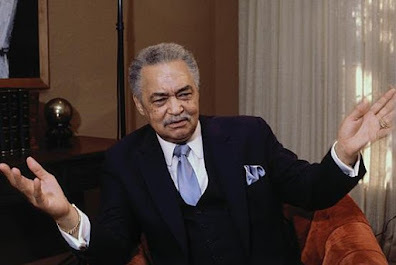 Mayor Coleman Young
Mayor Coleman YoungIn March, Mayor Young made an appeal to a skeptical group of Black ministers to support the gambling proposal to help solve the city's problems. Young told the Council of Baptist Pastors that "The state of Michigan is the biggest gambling house operator in the nation right now. You can go into any grocery or liquor store and bet any amount of money you want on today's number, look on television to see what the winning number is that day, and be paid off tomorrow."
The pastors were not swayed by the mayor's argument. Reverend James E. Lewis, the group's spokesperson, said emphatically that his group was totally against gambling. "We are acutely aware of the economic conditions of the city. However, it is our honest conviction that casino gambling would further erode the moral, spiritual, and economic fiber of our community."
After the gathering of pastors, a reporter asked the mayor why he did not campaign more vigorously for the proposition. In what may be the most inscrutable statement Mayor Young made regarding this issue, he replied, "I'm not interested in fattening frogs for snakes." Nobody knew exactly what the mayor meant beyond expressing his frustration.
Proposition C asked: Should the City Council be able to approve a limited number of hotel casinos to be licensed and regulated under State Law with one half of the proceeds of a tax to be imposed on casinos' gross revenue and paid directly to the City of Detroit?The Detroit News and the Detroit Free Press ran daily diatribes against Proposition C and daily horror stories about how casino gambling ruined Atlantic City in god-forsaken New Jersey, all the while getting paid for running Michigan Lotto numbers over the banner of their front pages. Their hypocrisy could not be denied.

On November 3, 1981, the day of the general election, Prop C was defeated for a second time by a similar 3 to 2 margin, slightly larger than in 1976. The wording of the proposal was short on specifics. Surely, casino gambling opponents in Detroit believed this was finally a dead issue.
***
In January 1988, Mayor Young's opening salvo to try for a third time to get Detroit voters to approve casino gambling was a press conference telling reporters, "Detroit never came out of the last recession. We need to take radical steps to preserve this city. Within days, I am going to set up a commission to study casino gambling and make a recommendation to the Detroit City Council." Political pundits were surprised the mayor would defy the two previous voter mandates against casino gambling.
In February, Mayor Young announced at City Hall that the members of the 60-plus committee ranged from top movers in corporate Detroit to little-known community activists. Former Detroit WJBK-TV Channel 2 anchor Beverly Payne was chosen by the mayor to be the commissioner in charge of administrating the $150,000, three-month study on the feasibility of casino gambling and its probable impact on Detroit.
After the press conference was concluded, Pastor John Peoples of the Calvary Baptist Church told the assorted press that "You can't ride to heaven in the devil's chariot. There is no way you can reconcile an immoral seed to produce a moral one." Reverend William Quick, pastor of the Metropolitan United Methodist Church added, "I think the issue of casino gambling is the Sword of Damocles that hangs over Coleman Young's head."
Casino gambling supporter and committee member Patrick Meehan told the press, "To think the Almighty is foursquare against casino gambling, yet he winks at the state lottery, horse racing, and bingo, I just find very hypocritical."
When questioned by the press, Jay Berman, spokesperson for the Archdiocese of Detroit said, "In traditional Roman Catholic theology, there is nothing intrinsically evil about the act of wagering. Catholics are free to make up their own minds about casino gambling in Detroit."
The Reverend Samuel White III of Scott Memorial United Methodist Church got in the last word, "It appears that some of the clergy are hypocritically and immorally supporting Coleman Young's casino gambling proposal. One has to question our appalling silence in the face of such flagrant evils. Gambling is sinful because it fosters avarice and idolizes mammon. It can make us greedy and worship the almighty dollar. The religious community of churches needs to have moral integrity to take a prophetic stand against casino gambling."
The essential issue and the players remained the same this time around, but religious casino opponents agreed to consolidate their efforts under an umbrella committee named United Detroiters Against Gambling to rally the religious community.
Their public relations campaign began with a color poster of Roman soldiers playing dice on the robe of Jesus at the foot of the cross. The caption read, "Over the years, some very influential people have looked down on gambling." The plan was to distribute 2000 of these posters, mostly to Detroit churches.
The opposition got some unexpected support from officials representing the Detroit Race Course, Hazel Park Harness Raceway, and Northville Downs. They came out united against casino gambling because they feared it would drastically affect their business and possibly lead to racetrack closures. They contributed a large chunk of money to the anti-casino forces. In politics, an enemy of my enemy is a friend of mine.
The mayor's committee considered European-style casino gambling which is usually kept small, requires identification, registration, and an entry fee. Most European gambling spots operate only 12 to 14 hours a day, and they offer no free drinks, no free meals, and no credit. One faction supported Las Vegas-style casinos but not wide-open like Vegas, where gambling dominates the landscape and the local economy. The issues of the number, size, location, and how the tax revenues would be used needed study and discussion.
Some socially conscious committee members wanted tightly controlled casinos discretely tucked away on the upper floors of existing hotels to bring business into the city at minimal cost. The Vegas-style casino faction won out because they favored 24/7, easy access casinos as a way to bring thousands of people into the city to create new jobs.
On June 8, 1988, forty-six casino gambling committee members voted to approve casino gambling, fifteen voted against, and three abstained. The committee was discharged of their duties. Now, the issue was in the hands of the City Council. Proposition Y was drafted and read: "If casino gambling is approved by state law, then it shall be prohibited within the city limits of Detroit and Belle Isle."
Critics of how the bill was worded noted that a yes vote is against casino gambling; a no vote is for casino gambling. The mere mention of Belle Isle was a dog whistle for opponents who were likely to vote yes. It was a red herring for supporters who needed to vote no. Because of strong opposition, the idea of using Belle Isle for a casino site was discarded five months earlier in February by the gambling committee.
Emotions were running high on both sides. Opponents ran a media blitz of full-page newspaper ads and radio spots everyday leading up to the August 2 primary election. Three days before the election, supporters and foes went head-to-head in a chant-down at Kennedy Square in a rally staged by casino supporters but disrupted by pro-gambling demonstrators.
This exercise in democracy resembled a "Tastes Great, Less Filling" shouting match in the bleachers of Tiger Stadium. Nobody got hurt except for Attorney General Frank Kelly's ego. He was shouted off the podium.
When voting day finally arrived. Detroiters voted for the third time another 3 to 2 margin against casino gambling (61%/39%). Mayor Young's throw of the dice crapped out. After voting, the mayor was exhausted, felt weak, and had a headache. His cousin and personal physican Dr. Claud Young took Coleman's vital signs and recommended several days of rest. "The mayor's condition is not serious," Dr. Young said. "For once, he decided to do what I told him to do."
 Box Cars
Box Cars***
On March 23, 1992, the Windsor, Ontario city council voted unanimously to approve a bid for casino-style gambling to bolster its sagging economy. If approved by Ottawa, Canada's capital city, the downtown Windsor riverfront casino could draw an estimated 50 million people annually from the United States and Canada. Detroit casino gambling supporters across the Detroit River saw Windsor's potential windfall gain as Detroit's loss of income. Ottawa approved the measure to legalize casino gambling in 1993. On May, 1994, Windsor opened a temporary casino called Caesar's Windsor.
The prospect of a Canadian riverfront casino re-ignited the debate over legalizing casino gambling in Detroit. Proponents estimated that Detroit casinos could generate as much as $26 to 50 million in yearly income for the city. Although Mayor Young was still an avid supporter, his ill health became a factor. After failing in four previous attempts, Young decided to allow other people to actively promote the gambling proposition.
When the mayor was asked to comment on plans for casinos in Windsor and Chicago, he took a jab at opponents of casino gambling. "All I can say is, 'I told you so'. If Detroiters did not approve gambling, some other city would emerge as the gambling capital of the Midwest. Casino gambling could be a source of 40 to 50 thousand jobs in this city, not to mention increased tax revenue and increased tourism."
Leading the movement to legalize casino gambling in Detroit in 1993 was sixty-three-year-old, retired Detroit Water Department employee David Greenidge, coordinator of the grass roots Citizens for Casino Gambling. Greenidge wanted to do something to help the city secure new jobs and increase its tax base. "Without those," he said, "we are nothing." He and several of his friends circulated petitions and secured enough signatures to place the measure on the June 2, 1993 Special Election ballot.
The major opposition came from Detroiters Uniting for Open Government, a religious coalition led by Reverend William Quick of the Metropolitan United Methodist Church, who helped defeat the previous attempts to open the city to casino gambling. The group was confident they could once again turn out the vote.
Public opinion appeared to shift in favor of casino gambling in Detroit after the move by Windsor to establish a riverfront casino on the Canadian side of the Detroit River, reducing the stigma for some voters. Windsor hoped to open a temporary casino in the fall.
Also softening public opinion towards casino gambling was when the Detroit City Council voted to allow real estate developers Ted Gatzaros and Jim Papas to place in trust 0.7 of on acre of their own downtown property to the Sault Ste. Marie Chippewa Tribe for an Indian-run casino, pending United States Department of the Interior approval under the "sovereign nation" statute. This move took the issue out of the hands of the voters. Eight Indian casinos already operated legally on reservation property in Michigan under federal agreement.
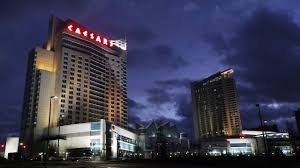 Caesar's Windsor Casino
Caesar's Windsor CasinoPolitical consultant to Mayor Young, Adolph Mongo, believed the voters were not as emotional this time about casino gambling because it was the fourth time on the ballot. After the blood sport of the last election, voters were weary and more complacent than ever before. Tina Lam, staff writer for the Detroit Free Press, noted "with less than three weeks left before the June 2nd vote, both sides in this quiet campaign have raised little money, generated little heat, and shown little evidence of organization."
After Proposition A went to the voters, the measure went down in defeat by a thin margin of 51% to 49%. In the three previous losses, each measure won by a two-digit margin rather than a 2 point margin. Supporters were edging closer to the victory they craved.
The Detroit Free Press attributed the close vote to low voter turnout, weariness over the casino gambling debate, and public resignation after the Windsor, Ontario City Council announced it was building a riverfront casino. The Free Press editorial page took a last shot at casino supporters, "Casinos are what you turn to when you are bankrupt of ideas and unable to tell the difference between blackjack and an urban renewal strategy."
On September 16, 1993, the Michigan House Oversight and Ethics Committee approved a resolution to ratify the Indian gambling compact signed by Governor John Engler. The Greektown Chippawa Indian Casino was a fait accompli and out of the hands of local leaders and Detroit voters.
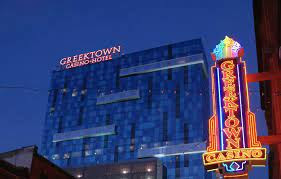 Greektown Casino
Greektown Casino***
In 1996, for the fifth time in twenty-two years, casino gambling was on the Michigan ballot. A coalition of well-funded supporters rallied under the banner of Michigan First. Their proposal was more specific than the four proposals that came before.
Proposal E would:
Permit up to three gaming casinos in any city that has a population of 800,000 or more and is within 100 miles of any state or country in which gambling is permitted, and has casino gambling approved by a majority of voters. [Detroit was the only city in Michigan that qualifed, allaying the fears of other communities across the state.]Establish a state-controlled Gaming Control Board to regulate casino gambling and keep organized crime out of casino operations.Impose an 18% state tax on gross gambling revenues. [In Vegas, this is called "skimming off the top." In this instance, the process is public and above board.]
Allocate 55% of tax revenue on gross gambling revenues to the host city for crime prevention and economic development.Allocate 45% of tax revenue to the state for public education.
Michigan First projected that construction of three casino complexes would cost $1.8 billion, creating 11,000 permanent jobs and requiring tens of millions of dollars in locally-sourced goods and services each year. The pro-gambling group ran television and radio spots which focused on how well Caesar's Windsor Casino and the Northern Belle Casino, a paddle-wheel boat docked within walking distance from Caesar's, were doing raking in Michigan dollars.
After the first year of Windsor's casino operations, an Ontario provincial government-sponsored study showed:
The six downtown hotels with a total of 1,171 rooms showed an increase in business from an average of 500 rooms rented to around 900 rented a day.Visiting gamblers, mostly from Detroit and its suburbs, spend $29 million on local Windsor businesses.Forty-five percent of Casino patrons ate in Windsor restaurants.A boatload of money was floating around the Michigan airwaves. A WXYZ-TV advertising executive said they were selling twice as many ads than they had in the 1992 campaign. The WXYZ-TV morning news hour ran no fewer than eighteen political ads.
Reverend Calvin Zastrow, a thirty-seven-year-old Assemby of God minister who lived in Midland, Michigan, actively worked against the casino proposition. The motivated anti-gambling activists were affiliated with churches that viewed gambling as inherently immoral and unethical. Zastrow's mantra was that gambling creates "Neighbors robbing neighbors, husband's beating wives, entrepreneurs declaring bankrupcy, lives being ruined, and souls being lost."
Casino spokesperson Roger Martin called Reverend Zastrow's repeal movement "a small coalition armed with half-truths and scare tactics supported by right-wing extremists from other states that declared war on Michigan voters and 15,000 jobs in Detroit.
Detroiters Uniting for Open Government centered their efforts on the greater Detroit religious community and through extensive advertising on radio, Black radio stations in particular. The governor and the attorney general were still lobbying against casino gambling in the state of Michigan.
Both major Detroit newspapers still ran endless diatribes against gambling, all the while earning revenue from running the State Lottery numbers in their papers and running ads for Vegas get-aways, Windsor gambing weekends, and cruise ship tours with casino gambling featured. The Detroit News and the Free Press benefited financially from the gambling advertising, yet they used every fear tactic they could to defeat Proposition E.
The anti-casino gambling proposal ran out of time and money. It fell short of the 247,000 signatures needed to qualify for the November ballot. Now in favor of the casino proposition, Mayor Dennis Archer flipped his opposition when he realized that license fees alone could top $100 million yearly from each of the three casinos. That kind of money could pay for a lot of city services that the city could not otherwise afford.
Turnout in Detroit for the November 2, 1996 statewide election was stronger than expected due to a bear hunting proposal and a measure to approve the Foxtown Stadium Complex, a dual stadium project (Ford Field and Comerica Park) downtown. Also there was something about the Windsor casinos vacuuming up $1 million a day of Michigan money that did not sit well with Michigan voters.
Finally, after twenty-two years of struggle, five gambling propositions, and untold millions of hours and dollars, Proposition E won by 59% to 42% in Detroit, a 17 point victory. The statistics further revealed that Wayne County voted 79% to 21%, a whopping 58 point margin. The three casinos granted licenses were the MGM Grand Casino, Motorcity Casino, and the Greektown-Chippawa Indian Casino. By the turn of the millenium, all three casinos were operational and earning income for the city of Detroit.

January 7, 2024
Detroit's Ghost Town Delray and O-So Memories
 O-So pop was a local Detroit soft drink sensation bottled in Delray at 8559-61 W. Jefferson Ave. Not as famous as Vernor's Ginger Ale but just as beloved. John Kar's bottling works opened in 1922, located north of the Peerless Cement factory and just south of the old Delray Bridge onto Zug Island, also known as the "one way bridge" no longer in use.
O-So pop was a local Detroit soft drink sensation bottled in Delray at 8559-61 W. Jefferson Ave. Not as famous as Vernor's Ginger Ale but just as beloved. John Kar's bottling works opened in 1922, located north of the Peerless Cement factory and just south of the old Delray Bridge onto Zug Island, also known as the "one way bridge" no longer in use.Adults from the Baby Boomer generation remember that O-So was the bargain pop of our day. The clear-glass bottled soft drinks were colorful and the flavors were fabulous. Linda J. Kulczyk remembers watching the mechanized bottle filler in action. "The place smelled like bleach and sugar water. Rock and Rye was my favorite flavor," she wrote on the Old Delray facebook site.
Other popular flavors were creme soda, lemon-lime, cherry, grape, strawberry, root beer, and orange. I don't believe they had a cola drink, though I could be wrong about that.
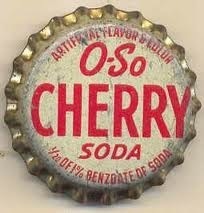 John A. Stavola, Jr. remembers "as a kid, they bottled the soda right there and the dude (perhaps Ed Kar, son of the founder) used to fish right out of the back window of the place." Diana Bors McPeck used to work there when she was young. Her grandparents were friends with the owners. Diana recalls, "I was paid in pop!"
John A. Stavola, Jr. remembers "as a kid, they bottled the soda right there and the dude (perhaps Ed Kar, son of the founder) used to fish right out of the back window of the place." Diana Bors McPeck used to work there when she was young. Her grandparents were friends with the owners. Diana recalls, "I was paid in pop!"One of the old timers working the same shift as me at the Zug Island coke ovens was nicknamed 'Pop'. He would buy several cases of assorted flavors of O-So pop every day in the spring and summer and roll them in from the parking lot on a hand truck (dolly) with a cooler full of ice. Pop sold the stuff for a dollar a bottle, a 400% markup. He also sold salted peanuts in the summer and fresh roasted chestnuts in the winter. On a hot day, everyone was glad to hear him call out "COLD POP."He was a door machine operator on the receiving end of the ramming machine. For the life of me, I can't remember his real name. Everybody just called him Pop.
When I worked as a laborer at Zug Island in 1967, the Delray downtown area already showed signs of two decades of neglect. Many of the shops and second story residences became little more than tenements for transient workers. After the Detroit Riots in July, the writing was on the wall for Delray. Like many other Detroit neighborhoods, White flight went into hyper-drive.
It is always sad to see an established community fall into ruin and abandonment. But almost one hundred years of history and heavy industry had taken its toll on the Delray neighborhood and turned it into what it is today, a virtual ghost town within the Detroit city limits.
Delray lost its ethnic heart and soul in the sixties and seventies. What was once a vibrant European mixture of Hungarian, Slovakian, and Polish immigrants dispersed among the Detroit suburbs, notably the Downriver areas of Allen Park, Lincoln Park, and Wyandotte.
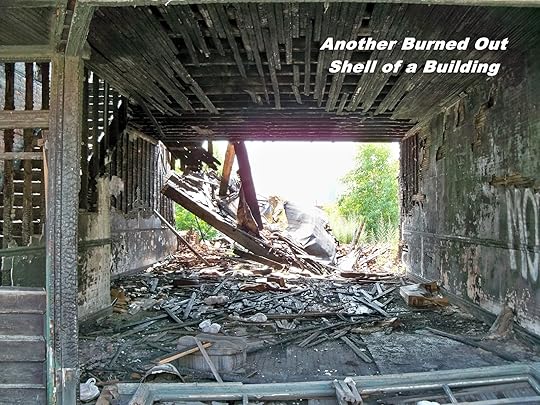
Now, all that's left of the Delray neighborhood are mostly memories and photographs fading in family albums. Remember any of these places? First Slovak Church (Holy Redeemer), St. John's Catholic Church, The Hungarian Village Bakery, Hevesi Cafe (with dining and dancing), Joey's Stables, Fox Hardware, Szabo's Meat Market, Delray Baking Company, Al's Bar, Kovac's Bar, and King's Chinese Restaurant. They are gone but not forgotten.
Realistically, Delray is zoned for heavy industry and will never recover as a viable residential area. But I could be wrong. What impact the new international transport bridge will have on Delray is yet to be known or felt. One thing is for certain, the area is ripe for some sort of redevelopment.
For more detailed information on the community of Delray, check out this link: http://en.wikipedia.org/wiki/Delray,_Detroit
January 1, 2024
Beverly Payne--WJBK-TV Channel 2 Trendsetter
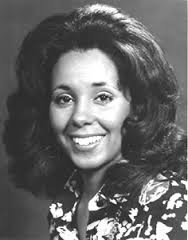
Beverly Payne Eyewitness News Publicity Photo
Beverly Payne was not a native Detroiter, but fate brought her to Detroit. She was raised in San Francisco and went to college there earning English and foreign language (French and Spanish) degrees. In 1968, she and her husband Harry R. Payne, an executive director of an international arbitration association, moved to Japan for his job.
In Japan, the Paynes hired a housekeeper. Soon boredom set in for Mrs Payne, so she began to study Japanese and picked up enough to teach Japanese businessmen how to speak and pronounce English properly. This led to Payne being interviewed on Japanese TV, which in turn, led to a job teaching English classes on her own educational TV program. After three years in Japan, the Payne family moved back to the United States, so Harry R. Payne could take a job in Detroit.
Not long after the family moved to the area, a friend suggested that Beverly (26) audition to co-host a new program at WJBK-TV Channel 2 in Detroit named Focus: Detroit. It was a public-affairs program that discussed issues important to Detroit's minority community, a largely ignored and underserved television demographic.
Payne was hired to begin on July 1, 1973 and teamed with experienced Channel 2 newsman Woody Willis for the Sunday morning program. Management wanted to see how she performed in the ratings rankings. Her numbers were positive.
In a move to capture a larger share of the housewife 18-to-49-year-old television audience, coveted by advertisers because they spend most of the household income, Channel 2 quickly promoted Payne to co-anchor the station's new 7 to 8 morning newscast and the noon news with Channel 2 veteran Vic Caputo.
Two years later, Beverly Payne was moved to the 6 pm newscast with Joe Glover, making her the first African American woman to co-anchor a prime time broadcast and gain celebrity status in Detroit. At the time, she was only one of four Black women in the country to co-anchor a daily, prime time newscast.
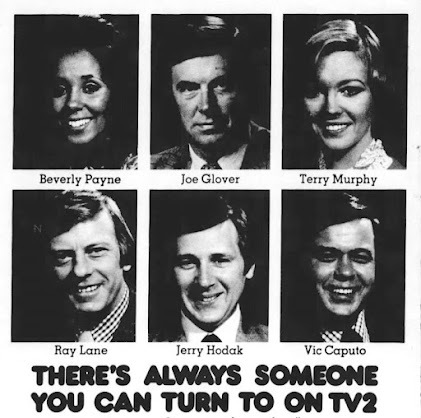
Eyewitness News print advertisement
Although Payne's meteoric rise appears to be seamless, she had a difficult hurdle to overcome. Detroit Free Press TV critic Bettelou Peterson explained in her column, "The housewife 18-to-49 demographic that Channel 2 wants to attract is also the most critical of women on the air.... Let a woman come across as aggressive and women resent her as do some men. Let a woman on the air seem too intelligent and she is disliked. But worst of all, let her look sexy, and she is unwelcome in the family living room where the housewife watches with her husband. Beverly Payne passes all the tests of being acceptable to men and women viewers. She projects an image of sincerity, trustworthiness, friendliness, and attractiveness."
Simply put, Payne was non-threatening to the Detroit viewing audience. Women began writing Channel 2 saying they watched solely to see what Beverly Payne was wearing. In response to that, Payne admitted in a fluff Detroit Free Press feature article that she spends "an inordinate amount of money on her wardrobe. I like simple clothes and designer clothes. I wear Halston and Geoffry Beene a lot. I see buying clothes and looking nice as part of my job."
When asked in the same interview if she found television glamorous, Payne candidly admitted, "The only time I feel glamorous is when I go to the bank.... People think television is glamorous, but there is incredible tension. We come across cool, but believe me, there is nothing glamorous about doing a live news show."
With television news celebrity comes great responsibility. News anchors are required to make personal appearances, host charity auctions, attend community service group events, and accept awards, that is, in addition to working their scheduled assignments. More often than not, the celebrity's personal life suffers.
Television news is a goldfish bowl inside a pressure-cooker. It requires its on-air talent to lead a somewhat schizophrenic life. Coming into people's homes everynight exacts a personal price. People feel like they know you which entitles them to violate the celebrity's privacy. Everywhere they go and everything they do in public is fair game for newspaper columnists. So even in their most private moments, celebrities have to be guarded with their behavior. Especially so for women.
The demands of celebrity must have weighed heavily upon Payne's domestic life, though she insisted "(her) chosen career was not responsible for the breakup" of her marriage. She and her husband Harry Payne Jr. divorced in mid-March of 1976 after twelve years of marriage. Beverly retained custody of their three sons Harry Payne III (10), Mark (8), and David (6).
In the year since Joe Glover was teamed with Beverly Payne, Channel 2's market research found they were reaching younger viewers without turning away their core audience. This news teaming had a calming on-camera chemistry.
In a business where your career hangs in the balance with every ratings report and the cold calculus of the station's earnings, Glover and Payne competed favorably for market share against Channel 4 in the ratings race, while Channel 7 remained far and away the ratings leader.
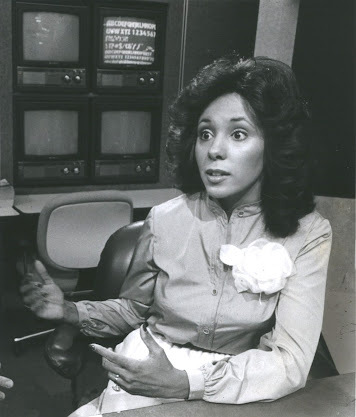 Beverly Payne being interviewed behind the scenes.
Beverly Payne being interviewed behind the scenes.All seemed fine until June 15, 1977, when Beverly Payne abruptly quit her $80,000/year job in protest over a live phone interview with the head of the Nazi movement in America. She was nursing a cold at home watching Channel 2 news when she saw her co-anchor Joe Glover allow a hate-filled rant against Jews, Blacks, and immigrants go unquestioned.
The 90-second interview with the national coordinator of the National Socialist White People's Party of America was allowed "to spew his hate over the TV2 airwaves without any balance." Payne criticized her colleague for not asking any probing questions and for the station not having booked a spokesperson from an opposing group for rebuttal. "I may have washed my career down the drain," Payne said in an interview, "but I have my integrity and my dignity."
Station manager Bob McBride refused to issue a public apology over the incident but also refused to accept Payne's resignation. The station continued to honor Ms. Payne's contract which had two years left to run. The station gave Payne a temporary leave of absence to allow Glover and Payne to soothe their egos.
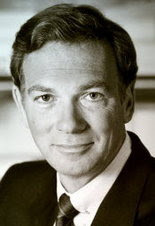 Bob McBride
Bob McBridePayne's fans stood solidly behind her, and they made it known to the station. Two weeks after her protest against WJBK, Payne returned to the Eyewitness News desk to co-anchor with Robbie Timmons while Joe Glover was on temporary assignment elsewhere. Station manager Bob McBride opened the Wednesday night broadcast apologizing to the audience for the offensive interview.
In September of 1979, Ms. Payne's agent negotiated a three-year contract with a substantial salary increase from $80,000 per year to $120,000. WJBK-TV management, not known for their generosity, realized Payne was too important to the station and its image. They did not want to take a chance on losing her to WXYZ-TV Channel 7, which had poached several of their top ratings earners in recent years like John Kelly, Marilyn Turner, and Al Ackerman.
Beverly Payne was the Channel 2 golden girl until November of 1979 when she was one of several journalists invited to a briefing session at the White House with cabinet members and President Carter. Channel 2's conservative management refused to let her attend calling the invitation "public relations puffery."
The decision was typical of WJBK management's failure to capitalize on an opportunity that would enhance Payne and the station's local stature. When she complained that if her co-anchor Joe Glover had received the invitation, the station would have sent him with an expense account. Her statement reopened old wounds. Management began to see Payne as a "troublemaker."
In November of 1980, the station sent Payne on a two-week charity mission to help feed starving Somalian children in Africa. She was able to raise $40,000 from Detroit viewers for the project. Her mission of mercy was filmed by a camera crew and later compiled into a WJBK-TV feature story. When Payne returned home, she was hospitalized at Mt. Carmel Mercy Hospital for dehydration and exhaustion. Her doctor ordered three weeks of rest.
When she returned to work, Payne announced her engagement to Guy Draper, a former chief of protocol in the Carter administration. The couple met at the Democratic National Convention in New York City. They wed on June 20, 1981, in Washington D.C. at St. Albans Church on the grounds of the National Cathedral. The bride wore a street-length, eggshell-colored lace gown. The reception was held at the Shoreham Hotel.
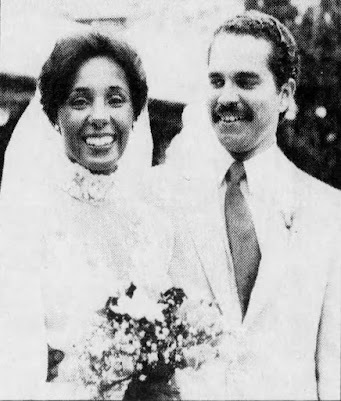 Beverly Payne and Guy Draper
Beverly Payne and Guy DraperPayne decided to use her husband's surname on the air beginning July 6, 1981. WJBK management was bewildered and miffed after all the years and money they spent promoting Beverly Payne to their Detroit audience. Payne insisted on using her married name--Beverly Payne Draper. She continued to work at the anchor desk until December 1982 when WJBK-TV suspended her without pay for an unspecified reason. Rather than buckle under, she resigned her position after nine years with the station.
In 1985, Payne launched a new career as a consultant and official spokesperson for the Michigan Commerce Department. Two years later in March 1987, after six years of marriage to Andrew Gay Draper, Beverly divorced him and dropped his name from hers. The reason was once again held private.
In an unexpected turn of events, Detroit Mayor Coleman Young nominated Beverly Payne in February 1978 to serve as administrator of the Casino Gambling Commission and its $150,000 budget. The 35 person committee was charged with studying and drafting a recommendation whether Detroit should allow gambling casinos within the city limits. A proposal was written which the voters rejected in a special election.
Glad to be free from her gambling commission duties, Ms. Payne began a consulting firm for small businesses named Beverly Payne & Associates in June 1988. A year and a half later, Ms. Payne announced her engagement to Michigan Senator Morris Hood (D-Detroit). In no apparent hurry to tie the knot, they were married twenty months later in a private, civil ceremony performed by Recorder's Court Judge Geraldine Bledsoe-Ford.
At some point, Beverly Payne moved back to her hometown of San Francisco to be close to family. She passed away at home on November 12, 1999, of complications from cervical cancer at the age of fifty-four. At Ms. Payne's request, there was no memorial service. She left behind three grown sons, five grandkids, two sisters, one brother, and her mother Virginia Wroten.
Beverly Payne's contribution to Detroit television history is that her success opened doors for other women and minorities at news desks across the city: women like Diana Lewis, Doris Biscoe, Robbie Timmons, Kathy Adams, Linda Wright-Avery, Carmen Harlan, Kai Maxwell, and Terry Murphy.
"These women were transformed by the power of television. Deserved or not, a certain glamor and credibility is attached to these golden beings whose fate it is to be on-camera. It is magical!" wrote Detroit Free Press reporter Donna Britt.
November 23, 2023
Diana Lewis--WXYZ-TV's Grande Dame of Detroit Nightly News
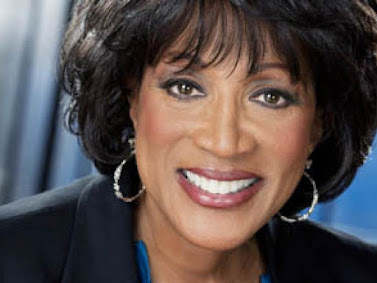 Diana Lewis
Diana LewisThirty-four-year-old Diana Lewis burst onto the local Detroit television news scene when she was chosen to co-anchor the 5:30 pm, Channel 7 Action News with bombastic Bill Bonds. Detroit Free Press television critic Bettelou Peterson wrote that "Diana Lewis comes across with strength to balance Bill Bonds' strong personality. She might have overwhelmed the more easy-going Jac Le Goff or John Kelly, Action News' other nightly news anchors." Finally Bonds met his match.
"It was amusing to watch Bonds and Lewis the first week they teamed for Channel 7's new 5:30 pm newscast. Bill knew he had tough competition and wasn't about to give Diana too much room. I don't think he actually looked at her once. He tossed her cues by saying "Diana" while looking resolutely straight at the camera," Peterson wrote.
To promote the 5:30 pm newscast, WXYZ-TV Channel 7 ran daily 3/4 page ads in the Detroit newspapers launching the team of Bonds and Lewis. Over a short time, they became more comfortable on-air together and became the news team to beat in the local Nielsen ratings race. Within a year, Detroit's other news stations adopted the White male, lead anchor and Black female, co-anchor format to compete head-to-head with Bonds and Lewis. WWJ-TV Channel 4 had Mort Crim and Carmen Harlan; WJBK-TV Channel 2 had Joe Glover and Beverly Payne.
***
Diana Lewis did not follow a lifelong ambition to be a television newsanchor. She grew up Diana Robinson in Coatesvill, Pennsylvania. After her schooling, she worked as a psychiatric social worker at Emreeville State Hospital working with troubled youth and as a public special education teacher at Scott Intermediate High School. Both experiences prepared her for the job she was destined to have co-anchoring with Bill Bonds.
In 1968, Diana Robinson's stepfather showed her an article in the Phildelphia newspaper. Phildelphia's WPVI-TV Channel 6 needed a part-time, assistant producer for a program named Black Book about issues that were important to the Black community. The next day, Ms. Robinson asked her students if they thought she should apply for the job. The next thing she knew, Diana was filling out an application.
The moment that changed her life occurred while writing a script and preparing for an appearance of author Maya Angelou. Just before the broadcast, Angelou cancelled because she wasn't feeling well. Diana went to the producer and asked what they were going to do.
"Kid," he said, "you're on!" That was the first time she had appeared on camera, and Diana realized she was good at it. "That day, I claimed my voice, so help me, to be a voice for the people."
Diana was long married to Glen Lewis, a sound editor for Paramont Pictures and Universal Pictures. They had two daughters, Donna and Glenda. The family moved to Los Angeles in 1974, so Diana could take a job with KABC-TV as a consumer investigative reporter. She began using her married name professionally--Diana Lewis.
After two years beating the pavement in Los Angeles for KABC-TV, Lewis received a phone call from a young, unknown actor/screenplay writer named Sylvester Stallone. He told Lewis he liked her investigative reporting. "I like your no-nonsense, hard edge. That's what I'm looking for."
"Looking for what?"
"Someone to play a TV reporter in a film I'm making."
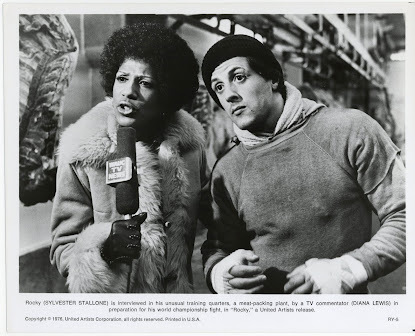
The film Rocky premiered in 1976 in time for the United States Bi-Centennial Celebration. Playing herself in the film, the director placed an Afro wig on Lewis' head and pointed her toward the cameras. She interviewed Rocky Balboa, a washed-up pug, as he tenderized a side of beef hanging in a packing house. The scene has since become one of the most memorable sequences in film history.
WXYZ-TV program director Phil Nye had hired Lewis when he worked in Los Angeles. Now he was the top programing person at Channel 7 looking for someone who was confident and could handle co-anchor Bill Bonds, who had his difficult on-air moments. Lewis had a levelheaded, calming influence that counterbalanced Bonds. The pair developed mutual respect for one another and dominated Detroit local news for many years.
One year into their run, the early 5:30 pm broadcast came in strong in the Nielsen ratings attracting the biggest audience of women 18 to 49 years old, the demographic advertisers love most. Men were watching too. Bonds and Lewis drew about 37 percent of the viewing audience the first time ratings data was available for the 5:30 pm Action News. The following year, the ratings were 44 percent, almost twice as much as Channels 2 and 4 together. Newspaper TV critic Chris Stoehr dubbed Bonds and Lewis the "King and Queen of Local Newscasts."
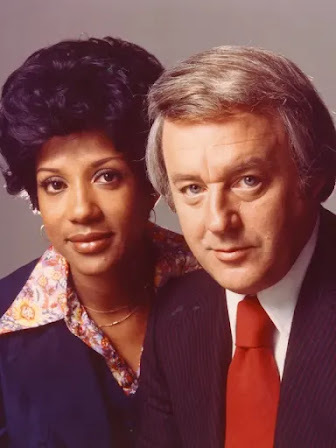 Bonds and Lewis
Bonds and LewisBy August 1977, Lewis hosted her own daytime show called AM Detroit where she tackled controversial issues of the day. Market research found that viewers felt she was too abrasive and aggressive for a morning audience of housewives. The station wanted her to be more likeable and less threatening, so they softened Lewis' hair, makeup, and wardrobe.
One good thing about working for Channel 7, each of the anchors had a yearly clothing allowance. In a behind the scenes interview with Channel 7's News Director Phil Nye, he explained the station's dress code. "The station pays for the news team's clothing, mostly purchased from Gwynn's in Birmingham. Bob Gwynn makes clothes to order for each reporter and anchorperson. Diana is an absolute pleasure to work with because she is dynamic. As for Bonds, he's a paradox; he swings from wild to conservative.... We don't want the clothes to upstage the content of the program. Their clothes should be subdued but stylish and fairly conservtive."
Detroit Free Press celebrity watchdog Bob Talbert, often publicly at odds with Bill Bonds, could not resist using Diana Lewis to bludgeon Bonds in his March 10, 1980 column. "You don't realize how good Diana Lewis is until you watch her take the lead anchor spot while Bonds is on vacation. You don't even notice Bonds is gone."
In 1982, The Detroit television market had no shortage of competent women co-anchors including Beverly Payne, Doris Biscoe, Kai Maxwell, Carmen Harlen, and Robbie Timmons. Diana Lewis' popularity and ratings led the field earning her a $500,000 three-year contract with a baby-blue Chrysler Imperial thrown in to sweeten the deal.
But when her contract was up in 1985, Lewis became the casualty of the contact wars when her contract was not renewed. Channel 7 once again raided Channel 2's talent pool and hired Robbie Timmons for the 5 pm newscast and Dayna Eubanks for the 11 pm newscast. Diana moved her family to Los Angeles, California, where her husband Glen was a film editor and sound effects man for Paramount and Universal Pictures.
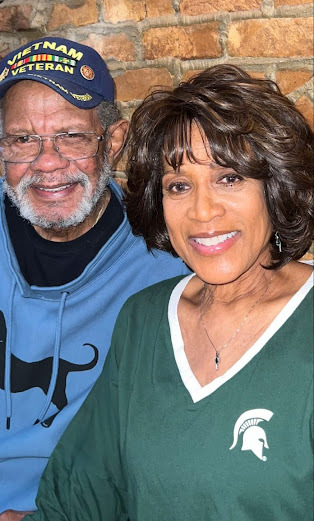 Glen and Diana Lewis
Glen and Diana LewisOne thing Lewis learned from her tenure with Bill Bonds was to land on your feet after a crisis. Lewis went national and took a position in October 1986 with CNN in Atlanta, Georgia, which lasted all of one week. "I didn't realize what a jolt it was going to be being a long-distance mother."
She didn't want to uproot her twelve-year-old daughter Glenda out of school in the middle of a term, and her twenty-year-old daughter Donna needed to finish college. Diana dusted off her SAG (Screen Actors Guild) card and took some television bit parts including reprising her role in Rocky 5.
After Lewis' three year absence, Channel 7 announced they would not renew Dayna Eubanks' contract. Eubanks and Bill Bonds had no on-screen chemistry and did not get along, so the station rehired Lewis in 1988 for an estimated $150,000 to co-anchor the 11 pm newscast and stop the ratings hemmoraging. Lewis admitted to the press that she missed the money and her celebrity status. She was happy to be back. Channel 7's public relations team did a hard sell advertising the on-air reunion of Bonds and Lewis.
Lewis (69) stayed with Channel 7 until her last broadcast on October 3, 2012. After forty-four years in television news, including thirty-five years at WXYZ-TV, Diana Lewis signed-off by addressing her audience for the last time, "To everyone at home, God bless you. Thanks so much for loving me. I love you back. Good night."
Diana Lewis hoped to retire and travel around the country with her husband, but soon after, Glenn Lewis developed memory loss and PTSD from two tours of duty as a U.S. Marine in Vietnam. Diana back-shelved her retirement plans to become his caregiver.
In the meantime, her brother, who was suffering from kidney disease, took care of their 101-year-old mother Doris Spann in Pennsylvania. When he died suddenly from heart failure, Lewis made the funeral arrangements and moved her mother to Michigan into the family home in Farmingham Hills.
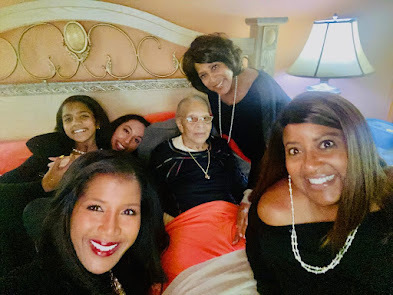 The Lewis women with family matriarch Doris Spann
The Lewis women with family matriarch Doris SpannLewis and her daughters did the best they could, but when Diana's back went out while lifting her mother, Diana asked for help from ProMedica Hospice in Southfield. Something she vowed she would never do. Diana was able to keep her mother at home until she passed away in 2022 at the age of 103.
In a heartfelt interview on April 23, 2023, with Cambrey Thomas from Hour Detroit magazine, Diana Lewis (80) spoke about the toll of being a caregiver. "Taking care of an ailing person can tax one's spirit more than I ever thought possible. We need to normalize the conversation... to recognize that asking for help and support should not be seen as a sign of failure or weakness but rather as one of courage."
Without realizing it, Diana Lewis embodied what her longtime co-anchor Bill Bonds would say when he signed-off at the end of every broadcast, "Stay classy Detroit!"
November 15, 2023
Bill Bonds and WXYZ Channel 7 Action News
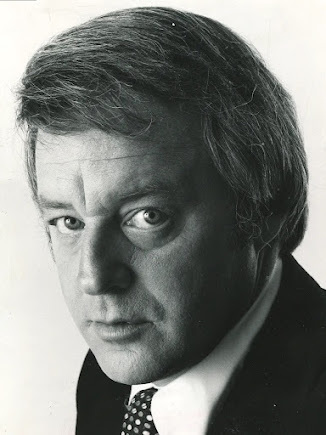 Bill Bonds WXYZ-TV Ratings Leader
Bill Bonds WXYZ-TV Ratings Leader "It's hard being Bill Bonds. You can't even imagine."--Bill Bonds
No other Detroit television news celebrity had more written about his every move and misstep than Detroit-born William Duane Bonds, better known as Bill Bonds. He was usually the number one news anchor in the Detroit media market for most of the 1970s, 1980s, and into the mid-1990s. Every point in the Arbitron and Neilsen rating television systemtranslates into how many viewers a show attracts measured against its competition. Millions of dollars of advertising revenue is at stake. Over the years, Bonds was a cash cow for WXYZ-TV.
Bonds had a serious demeanor and expressive face on camera. A lowered eyebrow or a furrowed forehead spoke volumes about how Bill personally felt about the story he was reporting. What made Bonds literally stand out more on the screen than his cross town competition was he wanted to appear as big as possible for the home audience. His face and shoulders, including his fabled toupees, filled most of the screen. When he looked into the camera, viewers felt like he was looking back at them.
After a Detroit Free Press reader poll in 1973 voted Bonds Detroit's Number One celebrity, Free Press staff writer Gary Blonston damned him with faint praise, "Bonds might not be the best newsman in town or even the best voice, but he certainly is the best theater in town. That explains much of why so many people are buying Bonds. He seems to be frequently overplaying the part of a television anchorman, except he really is one."
Over the years, Bonds had a love/hate relationship with the local press. Afterall, the free publicity is what kept his name in the news. Bonds has been described as flamboyant, pompous, arrogant, opinionated, insufferable, tart-tongued, and hot-tempered. Bonds has also earned himself many names like the Babe Ruth of Bombast, the Mad Prophet of the Airwaves, Emperor Bonds, Mr. News Christ, Billzilla, Infotainer, helmet head, scalp-weasel, rogue journalist, and the Sun King of Detroit News.
***
Billy Bonds was born in Detroit in the middle of a Michigan winter on February 23, 1932 during the depths of the Great Depression. He was the second of six children of Richard Bonds and Katherine Collins. What we know of Bill's childhood comes mostly from Bonds himself in a newspaper interview he did with Free Press feature writer Patty LaNoune Stearns in December of 1992 when he was sixty years old.
"I had a marvelous, loving childhood, thanks to my mother, Katherine, a bright caring Catholic homemaker. But I came from a very, very alcoholic family. My Scotts-Irish father was aggressive and domineering. My older brother Dick had a privileged relationship with him."
Bonds went on to describe an incident when he was in the first grade. "My dog got out and was hit by a car. My dad didn't want it in the house, so he put it on the porch in the dead of winter, and it froze to death. In the morning, he told me to throw the dog in the garbage. I was angry at my dad and with shovel in hand, I told him 'It's my dog. I'm going to bury it!' Standing up to my father empowered me and I liked it." This episode may be responsible for Bill's lifelong defiance of authority which marked much of his career.
Bonds grew up to be a rebellious student who was bored with his parochial education. He was encouraged to leave Catholic Central High school, then Royal Oak Shrine, followed by Berkley High School, and finally he dropped out of Royal Oak High School to join the United States Air Force and serve in Korea. While serving his country, Bonds passed his high school equalivancy test. When his enlistment was up, he used his G.I. Bill benefit to enroll at the University of Detroit, majored in political science, and graduated in 1960.
***
Bill Bonds' first broadcasting job was in Albion, Michigan at WALM-AM. He was paid one dollar an hour as a field reporter. From that modest beginning, Bonds followed opportunity and the road back home to Detroit to work at several local AM radio stations before landing a job in 1964 as on-air talent at the WXYZ-TV Channel 7 news department.
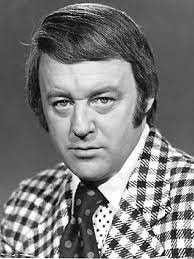
Within a year, Bonds was given an anchor position on a program that bore his name--Bill Bonds News. The fifteen minute color broadcast covered news, sports, and weather at 6:30 PM and 11:00PM. During the Detroit Riots of July 1967, the Channel 7 coverage was far superior to Channel 4 or Channel 2's coverage.
Detroit Free Press media reporter Bettelou Peterson lauded the WXYZ-TV news team for their in-the-field coverage, "(They) outdistanced the other stations as the best TV news reporting in Detroit. Bonds' face was particularly expressive as he came back on camera after watching film clips that were broadcast as fast as the film could be developed and sent to the newsroom in real time, each time delivering a small editorial reflecting his feelings." During that terrible week, Metropolitan Detroiters were riveted to their televisions. Bill Bonds became a certified news celebrity.
In 1970, an anchor position opened up at KABC-TV in Los Angeles. Sensing this was a good career move, Bonds interviewed for the position and was hired. He worked there for two years before returning to Detroit. For some reason, the Bonds magic did not work in California's largest media market.
While in tinsel town, Bonds landed bit parts in two Hollywood productions. First in the TV show It Takes a Thief with Robert Wagner in 1970 and the following year in Escape from Planet of the Apes. In both instances, he played a TV news reporter which was not much of a stretch for him. Bonds was released from his KABC-TV contact in February 1971. He did not do well in the Los Angeles ratings and the station decided to go in a different direction.
Two months later, Bonds returned to WXYZ-TV Channel 7. In an interview with Detroit Free Press gossip columnist Bob Talbert, Bonds revealed what his problem in Los Angeles was, "They wanted happy news with the anchors laughing it up. I believe news should be serious and informative. Yakety-yak happy talk on camera did not come easy for me."
In the two years since Bonds had jumped ship, Channel 7 news ratings faltered. WXYZ station manager Donald F. Keck lauded Bonds for his "performance and personal involvement in the Detoit community. Bill's presence will greatly enhance our overall news image and competitive position in our market." Keck noted that WXYZ-TV's news approach will shift from a "light" news style used by their competitors in favor of a more "hard-hitting" approach.
In his gossip column, Bob Talbert broke down Bonds contract for his readers, "Bill Bonds landed a $50,000 a year contact for anchoring their 6:00 PM and 11:00 PM newscasts. His primary responsibility is to boost WXYZ-TV's ratings."
***
With Bonds' return to WXYZ-TV, the station aggressively expanded its news department to make it more competitive in their television news market. Their news programs were expanded and renamed Channel 7 Action News and given a new on-screen look. The musical introduction was the same news theme that the ABC network used in its four other mega media markets: New York, Los Angeles, San Francisco, and Chicago.
The music was an expanded version of a brief melody taken from the movie score of Cool Hand Luke written by Lalo Schifrin for the famous tar-spreading scene. The musical interlude had a teletype-sounding melody that commanded viewers' attention. Following the lead-in, Bonds welcomed his audience and began reading the teleprompter. WXYZ's ratings began to slowly rise.
Channel 7 raided on-air talent from Detroit's other news organizations. From Channel 2, they lured Marilyn Turner to do the weather segment, and to balance Bonds' hard edge, amicable John Kelly was brought in to co-anchor the newsdesk. For sports, Dave Diles continued his segment until he decided to leave the station over a personal issue. That left an opening for Channel 7 to bring in Al Ackerman from Channel 4, who had just been fired for editorializing on the air, something Channel 7 encouraged. The advertising department began running ads proclaiming "We Got Who You Wanted." Their persistence paid off. Within two years, Channel 7 Action News was the top-rated news station in Detroit.
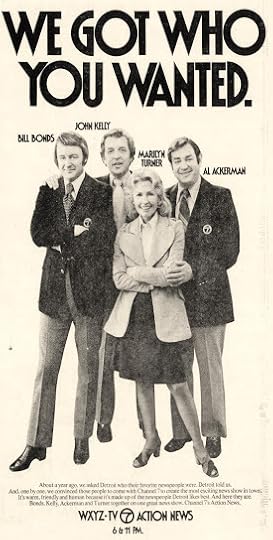
***
Bill Bonds' triumphant return to his hometown was marred by an incident which foreshadowed what would ultimately end his career. Early Sunday morning on November 18, 1973, Bonds, his brother, and their wives were returning home after dining at a West Bloomfield restaurant. Bonds (41) told police that his car was sideswiped by Kenneth Moody (18) of Milford, Michigan, before Bonds' car lost control and went into a ditch. Bonds yelled at Moody and a fistfight ensued. Neither Bonds nor Moody, a student at Michigan State University, filed assault charges. Moody received a ticket for reckless driving. Bonds called a tow truck.
WXYZ-TV spokesperson told the press that Bonds was "a little shook up, and he aches a little, but other than that, he is fine." Bonds was sidelined from his anchorman position for a week to recover from the beating he took. He was taken to William Beaumont Hospital where he was treated for bruises, a swollen eye, and a possible hairline fracture of his cheekbone.
In January 1974, WNBC-TV in New York was shopping for a new anchorman. WXYZ offered Bonds a $75,000 contract to keep him in Detroit. Afterward, the Action News team scored their highest ratings to date, but to his station's chagrin, Bonds was arrested in West Bloomfield Township for drunk driving, littering, and driving without a license on May 5, 1974.
After a patrolman witnessed Bonds throwing a paper cup from his car into the street, he was stopped. Corporal Dan Pitsos determined that Bonds was drinking in his car and drunk. When asked Bonds to show his driver's license, he could not produce it. Bonds was taken to the Oakland County Jail in Pontiac and was held for six hours until his wife Joanne posted a $100 bond.
Bonds was charged with drunk driving and littering, but the charge of failing to carry his license was dropped. WXYZ-TV spokesperson Phil Nye refused to say whether the station would take disciplinary action against Bonds if convicted. Reaction from viewers about Bonds was mostly supportive and favorable.
Bonds pleaded guilty on October 8, 1974 to a reduced charge of driving with visibility impaired "due to the consumption of intoxicating liquor." He was ordered to enroll in Oakland County's Alcohol-Highway Safety Program. Under the reduced charge, the conviction would remain on Bond's driving record for seven years rather than life, and he received four bad-driving points instead of six. Bonds also had to surrender his license plates for thirty days. Because he refused to take a police breathalyzer test, his driving privilege was suspended for ninety days.
WXYZ-TV general manager Jim Osborne announced that because this was Bonds' first offense, the station planned no disciplinary action, but in January 1975, Jac LeGoff from Channel 2 News jumped stations and slid into Bonds' primetime co-anchor spot at 6:00 PM, cutting Bonds back to the 7:00 PM and 11:00 PM News.
By the end of the month, Bonds suffered a mild heart attack while on a business trip to Ft. Lauderdale, Florida. Only the week before, he had recovered from the flu at Bennett Community Hospital. Bonds took a leave of absence to recover his health and returned to Channel 7 on May 5, 1975 to anchor the 7:00 PM news, again just in time for the May ratings sweep.
On June 12, 1975, Bonds announced that he was moving to WABC-TV in New York City at the end of August, for a salary reported to be somewhere between $120,000 to $150,000. But only eleven months after taking the WABC anchor job, Bonds returned to Detroit and was glad to be back. The New York City media market was so huge that Bonds made little more than a blip in the ratings, so his contract was not renewed. Bonds returned to the WXYZ-TV Action News Team to co-anchor with John Kelly.
***
Bonds was at the top of his game. His agent negotiated a multiyear contract which began at the $200,000 mark. Bonds was the highest paid newsanchor in town. Despite his tarnished history at Channel 7 for excessive absences from the newsroom and bad publicity for two alcohol-related incidents, Bonds remained the number one anchorperson in the Detroit media market.
In the Detroit Free Press' annual readers' poll taken in September of 1981 for Detroit's most popular local anchorperson, Bonds netted 1,929 votes of over 7,000 ballots cast. Mort Crim of Channel 4 was in second place with 676 fewer votes. No other Detroit anchorperson could come close to Bonds popularity with the general public.
When Bonds withdrew from the local Emmy Awards competition in 1980, he called the awards "ludicrous, insulting, and a sham." Bonds was the only news celebrity to publicly withdraw from the televised event. He told WXYZ-TV vice president and general manager Jeanne Findlater, "I am not going to play the part of an Eight Mile Road whore because of the pimping that's going on for these little statuettes."
Bonds pointed out that unqualified people outside the television news community (actors, sports celebrities, advertisers, and academics) chose the nominees, and a Channel 2 executive was chairman of the nominating committee. Channel 2 received 37 nominations, Channel 7 received 19, and Channel 2 received just 16. There was a clear conflict of interest.
After the televised event, The Detroit Chapter of the National Academy of Television Arts and Sciences announced that the Detroit Emmy Awards would no longer be broadcast because of public controversy and bad ratings. Such was Bill Bonds' influence over the local media scene.
But Bonds was about to be brought low with the death of his oldest daughter. On December 16, 1981, tragedy struck the Bonds' family when Joan Patricia Bonds (18), home for winter break from Michigan State University, was killed in a head-on collision with another car on a winding stretch of Commerce Road in Orchard Lake. Her Volkswagen Rabbit was hit by a Mercury driven by Russell William Brown (34), when it was believed his car crossed the center lane. Brown suffered a concussion and was treated at Osteopathic Hospital and released. Both cars were totalled.
The Orchard Lake Police investigation revealed that both Joan Patricia Bonds and Russell William Brown were legally drunk when the accident occured. Brown's blood alcohol level was 0.19 and Joan Bonds' blood alcohol level was 0.17. In Michigan, a person is legally drunk with a level of 0.10. Drunken driving was a misdemeanor carrying a maximum penalty of 90 days in county jail and/or a $500 fine. Brown was charged with the head-on crash.
Bill Bonds was off the air for almost three weeks after the death of his daughter before returning to anchor Channel 7's 6:00 PM broadcast. At the end of the hour-long newscast, Bonds, holding back tears, thanked the many viewers who had called or written to express their condolences.
Bonds' health began to deteriorate in 1982. He complained his back and legs began to give him problems and sidelined him from December until February. WXYZ-TV spokesperson told the press that Bonds was on special assignment to downplay his absence.
On October 15, 1983, Bonds (50) collapsed in Metro Airport just before his scheduled flight to Tokyo to cover Mayor Coleman Young's tour of Japan. He complained about acute stomach pains and difficulty standing up and was taken to Wayne County General Hospital and held for tests and observation for several days. He missed his trip. Ruth Whitmore, spokesperson for Channel 7 said, "(Bill) needs rest. We won't push him to travel." Medical tests indicated that doctors found no heart damage. Bonds returned to the news desk the following Wednesday.
On Friday, February 3, 1984, Bonds was hospitalized for exhaustion. His physican said his patient was suffering from persistent problems with his lower legs. Numerous station sources believed Bonds' recent round of health problems were the result of grief over the death of his daughter. Others believed he was being treated for drug and alcohol dependency. After a month of recuperating, Bonds returned to the anchor desk.
Ten months later, Bonds' wife Joanne Sipsock (47) filed for divorce. They were married for 24 years and had four children: Joan [deceased in 1981], John, and twin daughters Krissy and Mary. By all accounts, it was a messy divorce. Some unspecified time later, Bonds announced that he had a "significant other" named Karen Field, who was a manufacturer's sales representative. His health and general disposition improved.
***
Bill Bonds' most notorious moment to date of his broadcasting career happened on Friday, July 14, 1989. At the end of his 11 PM broadcast where he was noticeably slurring his words, Bonds challenged Mayor Coleman Young to a charity boxing match to benefit the Detroit Public Schools athletic program. He proposed a one-round showdown at the Palace of Auburn Hills on August 11th during halftime at the Detroit Pistons' charity all-star exhibition game.
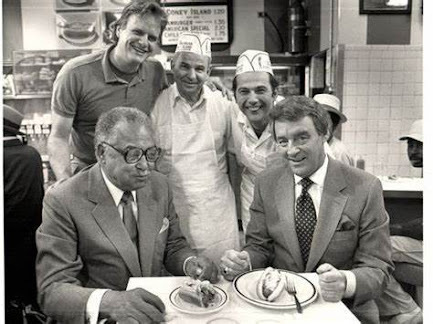 Mayor Coleman Young and Bill Bonds eating coneys downtown.
Mayor Coleman Young and Bill Bonds eating coneys downtown.Bonds suggested that both he and Mayor Young put up $10,000 each to donate, along with the proceeds of the exhibition basketball game, to help restore varsity sports in Detroit.
Local media wags dubbed the fight "The Showdown in Motown" and "Malice at the Palace." One reporter wrote,"This is a way for Bill Bonds and Detroit Mayor Coleman Young to settle the accumulation of small but distracting grievances between them."
Then, Bonds was absent without official leave from his Monday, Tuesday, and Wednesday night broadcasts. Station manager Tom Griesdorn arranged an impromptu news conference on Thursday to end speculation. "Bill called me earlier today and asked for some time off, vacation and personal leave, and we granted that request."
Griesdorn refused to comment on the barage of questions that followed. Usually, he answered "No comment!" or "That's none of your business." The entire incident was a public relations disaster for Channel 7.
Some Channel 7 staffers, pleading for anonymity, leaked the news that Bonds asked the station for help and some time off to enter an unidentified medical facility for an unspecified treatment. Three weeks later, Griesdorn confirmed WXYZ-TV's worst-kept secret, "Bill Bonds revealed that he has a problem with alcoholism, and he has checked himself into a California clinic for treatment."
After drying out, Bonds returned to the newsdesk in August. At the end of his 6 PM newscast, he confessed publicly that he was an alcoholic, but a sober one ready to do the news once more. Maybe this time he would win his battle over the bottle. For now, he would have to be satisfied with winning over the hearts of many Detroiters, who were all too familiar with alcohol addiction in their families.
***
In 1991, WXYZ-TV signed Bonds to a long term contract (5 to 7 years) for a million dollars a year prompting many people to wonder why he was worth so much considering his checkered history at the station. The answer was simple. Advertising rates were dependent on ratings achieved. Bonds was a ratings generator for the station for most of his long career. He appeared twice daily anchoring the news, he hosted prime time specials, anchored local election coverage, and made countless public appearances for the station. Being number one in his media market for twenty consecutive years earned Bonds the nickname "The Million Dollar Man."
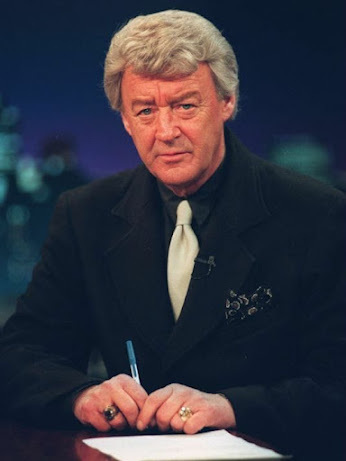 Always impeccably dressed on camera, Bill often wore Levis or shorts at the newsdesk.
Always impeccably dressed on camera, Bill often wore Levis or shorts at the newsdesk.Bonds kept his nose clean until an incident in April 1994 when his briefcase did not make it through security screening at Metro Airport. A pair of brass knuckles was detected at the inspection checkpoint. Although possessing a weapon was illegal in Michigan, the Wayne County Assistant Prosecutor said he determined there was "No criminal intent in this case. The brass knuckles were accidently possessed."
Bonds told authorities "I own four briefcases and grabbed the wrong one. Someone gave the brass knuckles to me as a gag-gift at work. I threw them in a briefcase and forgot about them." The knucks and the briefcase were turned over to airport police to be destroyed.
Once again, Bonds' celebrity status saved him considerable legal fallout, and he was able to catch his flight to New York City. Critics familiar with Bonds' background wondered, "How many bites at the apple can one person take?" Detroiters were about to find out.
***
On Sunday, August 7, 1994, Bonds was arrested on suspicion of drunk driving following a twenty-mile pursuit. A 1991, teal-blue Jaguar XJS was veering erratically on northbound Southfield Freeway. A driver called 911 and reported the incident. The sportscar swerved west onto I-696 before exiting at Orchard Lake Road. At a red light, a red Ferrari pulled up next to the Jag and revved its engine. Both cars peeled their tires when the light turned green, the Ferrari pulled out in front leaving the Jag fishtailing in its dust.
Another witness called 911 reporting that he saw Bill Bonds pull into a gas station to fuel up. On the way out of the station, Bonds smacked his car into a lamppost and then verred onto Indian Trail coming within inches of colliding with another car. As Bonds turned west down Commerce Road, five police cars closed in on him. It was soon discovered that the Jag did not belong to Bonds. It was a Channel 7 company car that he was joyriding in.
The Orchard Lake Police used video and audiotape to record Bonds as he performed a sobriety test while seated in the car. He declined a breathalyzer test and a standing sobriety test, citing neurological problems from an unspecified orthopedic condition--an excuse he had used successfully before.
Police later obtained blood samples after the arrest which showed Bonds' blood alcohol was 0.21%--twice the legal limit. He was jailed for twelve hours until his second wife Karen posted bail. If convicted, he faced six months in jail, a $500 fine, a suspended license for six months, and community service. Two days later, Free Press reporter Susan Ager wrote, "Bonds is captivating because he is an exquisitely flamboyant failure at self-improvement."
This incident threatened to end Bonds' reign at the summit of Detroit television news. Station manager Tom Griesdorn announced to the press that Bonds "asked for and was granted a personal leave of absence, the duration of which will be determined by the outcome of the allegations." Bonds remained in seclusion at his Union Lake home.
On August 11, 1994, Bonds was suspended from WXYZ-TV by Griesdorn pending "successful completion of alcohol treatment in Atlanta at Talbott-Marsh Recovery Center until his health is up to speed. The station wishes Bill Bonds every success as he sets about combating his addiction to alcohol once and for all." This was Bonds' third attempt at alcohol rehabilitation.
On December 2, 1994, Bonds pleaded guilty to a reduced charge of driving with an unlawful blood alcohol level; the driving under the influence charge was dismissed. His sentence included 12 months of supervised suspension with a 270-day license suspension, continued outpatient alcoholism treatment, a $1,115 fine exclusive of court costs, and attendance three times a week at Alcohol Anonymous meetings. If he did not comply with all stipulations of his sentencing, he would be jailed for 90 days.
On January 11, 1995, WXYZ-TV fired Bonds. "We've simply decided to hold our head high and face the future without Bill Bonds," said General Manager Griesdorn. "This is not a personal decision but simply a judgement about what is best for the station's long-term interest." Bill Bonds' long career with WXYZ-TV was over. Despite attempts to regain his footing at other Detroit media outlets, the old magic was gone. He was reduced to being a pitchman for Turf Builders and Gardiner-White Furniture.
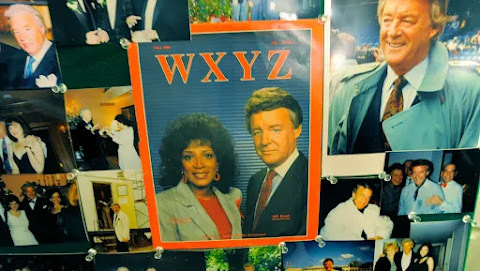 A collage of photos from Bill Bonds' funeral.
A collage of photos from Bill Bonds' funeral.On December 13, 2014, Bill Bonds died of a heart attack at St. Joseph Mercy Hospital in Pontiac, Michigan at the age of eighty-two. His visitation was on December 18th at Lynch & Sons Funeral Home in Clawson, with a funeral mass held at Holy Name Catholic Church in Birmingham the next day.
Despite Bonds' human failings, many thousands of working-class Detroiters admired him for his pluck, bluntness, and tenacity. He will be remembered for his on-air swagger, piercing gaze, defense of the underdog, and his authoritative delivery of the news.
September 15, 2023
The Remarkable Mother Waddles--Patron Saint of Detroit's Poor
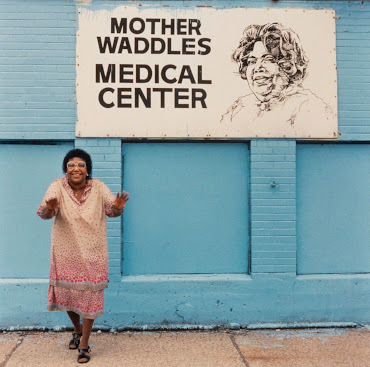 Mother Waddles Perpetual Mission eventually expanded to include her church, a kitchen/restaurant for the poor and downtrodden, a job training program, job placement services, and a health clinic.
Mother Waddles Perpetual Mission eventually expanded to include her church, a kitchen/restaurant for the poor and downtrodden, a job training program, job placement services, and a health clinic.Long before Mother Waddles became an institution in the city of Detroit, she was no stranger to adversity. Born Charleszetta Lena Campbell in St. Louis, Missouri, on October 7, 1912, she was the oldest of three children of seven who survived into adulthood, born to Henry Campbell and Ella Brown.
Her father Henry ran a successful barber shop which doubled as a popular meeting place for African American men in their local community, until he cut a customer's hair who had the contagious skin disease impetigo. Unknowingly, Henry Campbell cut other customers' hair with the same clippers, including some fellow church members who came down with the ailment. Overnight, word spread throughout his community and congregation that Campbell's Barber Shop was the cause of the outbreak. Members of his congregation shunned him and his family. Campbell lost not only his business but also his self-respect.
Charleszetta was only twelve years old when she witnessed her father die a broken man. She never forgot his despair and the lack of empathy shown to him by their congregation. Miss Charleszetta Campbell quit school in eighth grade despite her love of school and good grades. She began working as a domestic servant to help support her mother and two younger sisters. At the tender age of fourteen, Charleszetta became pregnant by her twenty-four-year-old boyfriend who eventually left her to fend on her own.
During the heart of the Great Depression, Charleszetta met and married a thirty-seven-year-old truck driver named Leroy Welsh. She was twenty-one. In 1936, the family moved to Detroit. Together, they had six children before she divorced him in 1945. She felt he had no ambition and was not doing his share to support her and her children.
Alone and with seven kids to feed, Charleszetta worked as a bar maid and a "numbers" (illegal lottery) collector to supplement her welfare and Aid to Dependent Children checks, and from a tub in front of the house, she sold barbequed ribs on the weekends to make ends meet. In life, circumstances determine actions, or so it seems. Charleszetta spent the next five years in a common-law marriage with Roosevelt Sturkey and bore him three children before he died unexpectedly.
Finally, with ten children in tow, she found Peyton Waddles and married him in 1950. Waddles worked for the Ford Motor Company and helped his wife in her quest to feed the hungry and clothe the poor. They remained married for thirty years until Peyton died in 1980.
***
In the mid 1940s, Charleszetta began studying the Bible and was ordained twice: initially in the First Pentecostal Church and later, after more study, in the International Association of Universal Truth. By the late 1940s, she began holding Bible readings and prayer meetings in her home with her neighbors and family members.
With the help and support of her new husband, Reverend Charleszetta Waddles founded the Helping Hand Restaurant offering good-tasting, home cooked, soul food meals for 35 cents a plate for Detroit's poor, all cooked by her in her own kitchen and served up in the living room. Nobody was turned away. Her mission ministered to homeless street people, unwed mothers, abused wives and children, the sick, the elderly, and anyone who was hungry and needed a helping hand.
At first, she and her kids did all the work, but soon neighbors and fellow churchgoers volunteered to help. Menu items included smoked rib ends, Southern fried chicken, and ham hocks with two sides of either boiled cabbage, black-eyed peas, rice, grits, baked beans, seasonal vegetables, or collard greens.
If anyone was hungry and did not have a quarter and a dime to pay, dinner was on the house. In the thirty-four years of its existence, the restaurant had several location but never increased the price of its meals. The kitchen/restaurant finally closed in 1984 after a fire destroyed it and everything in the building.
Mother Waddles believed in pragmatic Christianity specializing in emergency help. "The church should get beyond religious dogma and focus on the real needs of people. There is no fire and brimstone after death, but there is plenty of hell in Detroit," she said.
In 1963, Lonnie D. Moore came to her mission a wreck after his mother had died. He had nowhere else to turn. Reverend Waddles calmed him, "I'll be a mother to you." She provided Moore with a place to stay and fed him in exchange for volunteering as a dishwasher. He was the first person to call her Mother Waddles and the name stuck. Her nickname Mother Waddles became the branding her organization was lacking.
***
On her way to becoming a one-woman social-services agency in one of Detroit's most poverty-stricken neighborhoods, Mother Waddles and her Perpetual Mission had many setbacks. In the 1970s, when Detroit and the national economy were reeling from the Oil Crisis, Mother Waddles Perpetual Mission was there to provide services for unemployed autoworkers and their families. In February of 1970, her Mission was burglarized three times.
The first robbery was of typewriters the Mission used to train women how to type. The second time, the Mission's public address system used for Sunday services worth $1,500 disappeared. Then, at the end of the month, thieves took away the Mission's entire filing system that held the contact information for their referral services, emergency shelters, job centers, medical aid, social services agencies, and donor lists. Although police reports were filed, no concerted effort was made to discover who the robbers were or what their motives were beyond money.
Mother Waddles' charities always ran on a wing and a prayer. Dedicated volunteers helped run the kitchen and clothes distribution center, leaving her to concentrate on fundraising from private organizations and church groups, pledge drives, rummage sales, and talent shows, but never government funding. Waddles believed that government red tape and regulations were a fatal noose that wasted time and money.
In an effort to make money for her Mission, Mother Waddles self-published a thirty-six page booklet of her soul food recipes in October 1970. Fifty thousand copies were printed and hand-assembled by volunteers at the Mission. Each copy sold for $2 but only about five thousand sold the first month, prompting Mission spokesperson Maggie Kreischer to remark, "I just hope we can pay the printing bill." When I recently checked for copies of Mother Waddles' Soul Food Cookbook in September 2023, prices ranged from $200 to $450 for used copies.
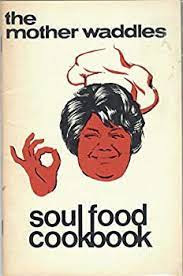 On November 15, 1970, Lee Winfrey wrote an editorial in the Detroit Free Press titled "Debt-Ridden Mother Waddles to be Absorbed by 'System'." It read, "If Mother's God-intoxicated energies are black-coffeed into financial sobriety, something appealing will be lost." Translated into plain English it means, if the charity is to surive, it will need to be managed better. The Missions' recordkeeping was minimal at best and all but inscrutable. To save her charities, auditors were called in to see how bleak the situation was.
On November 15, 1970, Lee Winfrey wrote an editorial in the Detroit Free Press titled "Debt-Ridden Mother Waddles to be Absorbed by 'System'." It read, "If Mother's God-intoxicated energies are black-coffeed into financial sobriety, something appealing will be lost." Translated into plain English it means, if the charity is to surive, it will need to be managed better. The Missions' recordkeeping was minimal at best and all but inscrutable. To save her charities, auditors were called in to see how bleak the situation was.The following year brought more bad news. On February 3, 1971, a "religious fanatic and sick man" (Mother Waddles' own words) named Willie Green (51) entered the Mission ranting scripture and attacked two people in separate incidents, a man and a woman. While the police were in transit, Waddles tried to settle the man down and put him at ease but with little success.
When two patrolmen arrived on the scene, Green pulled out a handgun. Officier Daniel G. Ellis (29), pushed his partner out of the line of fire and took two slugs in the chest and right leg. He was DOA before medics could get him to the hospital.
Further investigation revealed that Willie Green had a long criminal record with fourteen convictions extending back twenty-eight years. At his trial nine months later, Green was found innocent by reason of insanity in the slaying of Officier Daniel G. Ellis.
In January of 1984, a warehouse fire destroyed 50% of the food and clothing donations for the needy, and in November, just before Thanksgiving, the Black Firefighters Association delivered a truckload of food and clothing to the Mission meant for distribution to the poor.
That evening or early the next morning, thieves described as neighborhood toughs snapped the locks from two of the warehouse's six doors and emptied the building. Trying to downplay the robbery, Mother Waddles told the press, "You know it hurts, but it doesn't bring me down."
***
But amid the setbacks the Perpetual Mission battled throughout its existence, bright moments shined through too. For Christmas in 1989, Detroit boxer Tommy Hearns brightened the holiday for many struggling Detroiters by donating $3,000 worth of frozen turkeys and toys to Mother Waddles Perteptual Mission. Hearns was eight years old when Mother Waddles' kitchen fed him and his family when they were hungry. Several Christmases later, Detroit rocker Ted Nugent contributed six hundred pounds of dressed, wrapped, and frozen venison (deer meat) and about 1,000 pounds of clothes for the shelter.
The 1990s began badly for the Mission. Between January and April, their storage facility suffered nine break-ins. Mother Waddles told the press that the only way to prevent further break-ins was to install iron security bars on all the doors and windows. She mentioned in the newspaper article that the cost would be $3,500 which the Mission could not afford.
As had happened so many times before, Providence smiled upon Mother Waddles. Paul and Lynn Lieberman of Bloomfield Hills read in the local papers about the latest break-ins at the Mission and offered to pay for the installation of the security doors and windows. Once again, Mother Waddles' deep faith in the transcendent goodness of people shone through brightly on this occasion.
Mother Waddles' innercity Detroit charity work caught the attention of Michigan's outgoing governor George W. Romney, who was soon to become a cabinet member in the new President-elect Richard M. Nixon's administration. Romney believed Mother Waddles was the living embodiment of the "Black self-help" platform that Nixon campaigned on.
Romney wrangled an invitation for Dr. Charleszetta "Mother" Waddles to attend the 1969 Nixon Inauguration as part of the Michigan delegation. Included in the invitation were invitations to a tea for distinguished ladies, a Republican Governor's party, the vice-president's reception, the swearing-in ceremony for the President, and the Inaugaral Ball at the Smithsonian Institute. "I feel like a movie star, "Waddles remarked to the local Detroit press.
But what to wear?! To help Mother Waddles dress for the occasion, WXYZ-TV sponsored her wardrobe chosen from Lane Bryant women's store. For the swearing-in ceremony and the receptions, Waddles wore a velvet-trimmed knit suit. But for the Ball, she wore a floor-length, pink silk, caftan gown. Lane Bryant general manager Patti Hanes loaned Waddles her milk stole for the occasion. To chauffeur Reverend Waddles around Washington D.C., Thompson Chrysler Inc. loaned her a charcoal Chrysler Imperial and a driver.
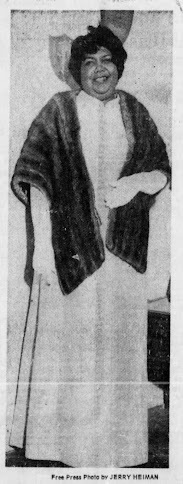 What was a Cinderella-like experience for Mother Waddles was commemorated in a photograph of her decked out in the mink stole which ran in the society pages of the Detroit newspapers.
What was a Cinderella-like experience for Mother Waddles was commemorated in a photograph of her decked out in the mink stole which ran in the society pages of the Detroit newspapers.But in a Democrat town like Detroit, partying with the Republican elite did not sit well with some blue collar folks. Rumors began to circulate that Mother Waddles was getting rich on the backs of the people she purported to help. In a public response, Waddles skirted the issue, "I'm in the business of loving the hell out of folks. It's a joy, it really is."
As Mother Waddles' fame grew, she became honored with testimonial dinners from civic and service organizations for her "service to humanity." Corporate donations and foundation grants increased as Mother Waddles' charity work was celebrated publicly.
Disney-MGM Studios in Orlando, Florida began filming a documentary in 1990 about Reverend Charleszetta "Mother" Waddles, underwritten by a $175,000 grant from Warner-Lambery Company (Listerine mouthwash). Mother Waddles' charities were additionally pledged $100,000 over the next five years for Waddles' one-woman war on poverty. The documentary was titled You Done Good! It was widely televised on PBS stations across the country.
Most Detroiters today know Mother Waddles' name from billboards along the highways advertising her car donation program which began in 1992. A used car business was set up to accept running used cars in return for tax write-offs equalling Kelly Blue Book values.
After being cleaned up and minor repairs made, the cars were priced from $300 to $999 and sold from Mother Waddles' Used Car Lot. For its first full year of operation in 1993, car sales totalled 1.4 million dollars, allowing another location to open the following year. All the profits went back into the Mission. This program became the financial backbone of the Perpetual Mission.
 Even at the age of eighty, Reverend "Mother" Waddles worked twelve-hour days. But on November 17, 1992, she was hospitalized and listed in serious condition in the cardiac unit of Michigan Health Center. Clifford Ford, acting as Mission spokesperson, told reporters, "(Mother Waddles') health issues are from attempting to stretch that which is virtually unstretchable." Her doctors recommended that she pass on the work of the Mission to others. What she needed most was some prolonged rest.
Even at the age of eighty, Reverend "Mother" Waddles worked twelve-hour days. But on November 17, 1992, she was hospitalized and listed in serious condition in the cardiac unit of Michigan Health Center. Clifford Ford, acting as Mission spokesperson, told reporters, "(Mother Waddles') health issues are from attempting to stretch that which is virtually unstretchable." Her doctors recommended that she pass on the work of the Mission to others. What she needed most was some prolonged rest.Almost nine years later on July 12, 2001, Mother Waddles died at the age of eighty-eight from cardiac arrest at her Detroit home. In her lifetime for service to the poor, Waddles received over 300 awards and honors including entry into the Michigan Women's Hall of Fame. Public viewing was scheduled from 9:00 am until 9:00 pm on July 18th at the Swanson Funeral Home on E. Grand Boulevard.
Over 1,000 mourners gathered at Mother Waddles' funeral ceremony on Thursday, July 19th at the Greater Grace Temple on Schaefer Road. The all-day celebration was attended by politicians, pastors, the press, and many of her admirers.
Detroit Free Press reporter Alexa Capeloto described Mother Waddles' burial this way:
Immediate family members wore white as a tribute to their famous relative who donned white at funerals because she considered funerals celebrations of life. Relatives carried flowers in her honor, black roses for her children and gold orchids for her grandchildren.
After the service, a horse-drawn carriage transported Charleszetta Waddles' white and gold-trimmed casket to Elmwood Cemetery for burial. Ten white doves--one for each of her children--were released as a symbolic freeing of her spirit.
Mother Waddles Grandson Wants Detroit to Name a Street After His Grandmother
August 26, 2023
Detroit's Forgotten Speedboat Champion Gar Wood
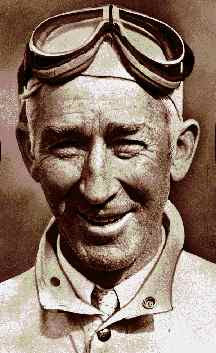 Garfield "Gar" WoodOne of the least remembered Detroit sports celebrities is speedboat champion Garfield "Gar" Authur Wood. He was known as the "Grey Fox of Algonac" by many in the speedboat racing world. He was the first person to go over 100 mph on the water. Gar Wood won five straight powerboat Gold Cup races between 1917 and 1921. He won the British International Trophy for Motorboats known as the Harmsworth Trophy nine times and retired from speedboat racing in 1933 to concentrate on business concerns.
Garfield "Gar" WoodOne of the least remembered Detroit sports celebrities is speedboat champion Garfield "Gar" Authur Wood. He was known as the "Grey Fox of Algonac" by many in the speedboat racing world. He was the first person to go over 100 mph on the water. Gar Wood won five straight powerboat Gold Cup races between 1917 and 1921. He won the British International Trophy for Motorboats known as the Harmsworth Trophy nine times and retired from speedboat racing in 1933 to concentrate on business concerns.Gar Wood was born in Mapleton, Iowa on December 4, 1880. His father was a patriotic Civil War veteran and named Gar after the current president James A. Garfield and his vice-president Chester Arthur. Gar was the third of twelve children. As a growing boy, Gar assisted his father who was a ferryboat operator on Lake Osakia in Minnesota. It is here where he learned his love of boating and developed his mechanical skill for inventing devices to solve mechanical problems.
 Without any formal engineering training, Gar Wood invented the hydraulic lift for the titling beds of coal trucks in 1911 at the age of thirty-one. In addition to the dump truck, his company developed the self-packing garbage truck familiar in every corner of this country. In all, Gar Wood held over thirty United States patents making him a multi-millionaire by the age of forty.
Without any formal engineering training, Gar Wood invented the hydraulic lift for the titling beds of coal trucks in 1911 at the age of thirty-one. In addition to the dump truck, his company developed the self-packing garbage truck familiar in every corner of this country. In all, Gar Wood held over thirty United States patents making him a multi-millionaire by the age of forty. Gar Wood and his eight brothers established the Wood Hoist Company which soon became Garwood Industries. Alongside industrial giants like Ford, Dodge, and Chalmers, the family built an industrial empire around the hydraulic lift which enabled Gar to pursue his love of speedboat racing.
Gar Wood and his eight brothers established the Wood Hoist Company which soon became Garwood Industries. Alongside industrial giants like Ford, Dodge, and Chalmers, the family built an industrial empire around the hydraulic lift which enabled Gar to pursue his love of speedboat racing.In 1916, Gar Wood purchased his first motorboat naming it Miss Detroit. The following year he put a Curtiss "12" airplane engine in a speedboat against the advice of everyone and won the 15th Annual Gold Cup Race on the Detroit River. Fours years later, he set a new water speed record of 74.87 mph. In the next twelve years, he and his racing team built ten Miss America's and broke the water speed record five more times raising the speed to 124.86 mph on the St. Clair River in 1932.
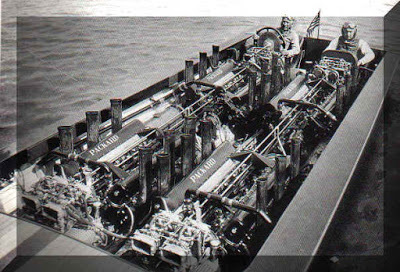
Miss America X was the last of Gar Wood's racing boats. The $600,000 speed boat was powered by four 1800 horsepower, twelve cylinder Packard engines run in tandem in a double-hulled boat. The boat's stringers were made of top quality spruce with the rest of the boat made of mahogany. This was the first boat to go over two miles a minute using 10 gallons of fuel per mile when full open. After Wood won the international Harmsworth Trophy in 1932 and 1933, he retired from racing leaving his son to carry on the family tradition. Gar Wood did more to develop the American speedboat sport than anybody.
In the 1930s, Garwood Industries built a new boat plant in Marysville, Michigan capable of producing 1,200 quality custom boats a year. Their two basic commercial models were a 28' runabout and a 22' runabout. In all, the factory produced 10,000 boats before the company converted over to the war effort during World War II. The company had extensive military contracts for military hoists, hydraulic units, dump trucks, tow trucks, and transport trucks. After the war, Garwood Industries quit boat production in 1947.
In his later years, Wood worked on a commercially feasible, battery-powered electric automobile. His electric car used eight 12-volt lead batteries connected in a series to power two specially designed 90-volt, 2 hp DC motors. The top speed was 52 mph and cost about twenty cents to recharge the batteries. The car was named the Gar Wood Super Electric Model A and was featured in the July 1967 issue of Popular Mechanics.
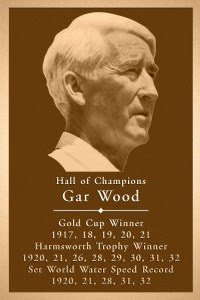 Garfield Arthur Wood died from stomach cancer at the age of ninety on June 19, 1971 and was buried in Algonac, Michigan. Upon his death, Detroit News reporter George Van wrote, "To the public, he was Tom Swift, Jules Verne, and Frank Merriwell, with a little bit of Horatio Alger thrown in."
Garfield Arthur Wood died from stomach cancer at the age of ninety on June 19, 1971 and was buried in Algonac, Michigan. Upon his death, Detroit News reporter George Van wrote, "To the public, he was Tom Swift, Jules Verne, and Frank Merriwell, with a little bit of Horatio Alger thrown in."A short clip of Miss America X and Gar Wood in action winning the Harmsworth Trophy in 1932.
https://www.youtube.com/watch?v=CMlahrYMF74



